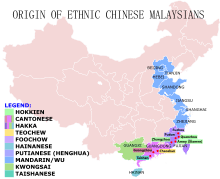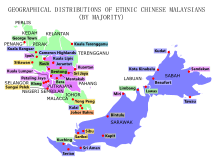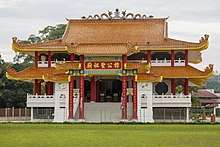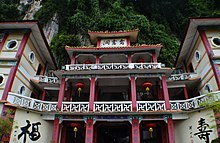Malaysian Chinese
Malaysian Chinese people or Chinese Malaysians[6] (Chinese: 馬來西亞華人; Malay: Orang Cina Malaysia) is a local ethnic group in Malaysia. The group is defined as Malaysian citizens of Chinese (Han Chinese) ethnicity. Today, they form the second largest ethnic group after the Malay majority. Most are descendants of Southern Chinese immigrants who arrived in Malaysia between the early 19th century and the mid-20th century.
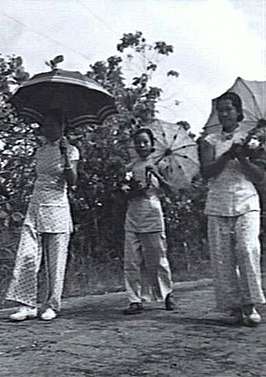 | |
| Total population | |
|---|---|
| 6,642,000[1] 23.4% of the Malaysian population (2016)[2] | |
| Regions with significant populations | |
Penang, Kuala Lumpur, Johor, Perak, Selangor, Sarawak Christmas Island[3] | |
| Languages | |
| Mandarin (lingua franca), Malaysian (national language), English Mothertongue languages: Hokkien, Cantonese, Hakka, Teochew, Foochow, Hainanese, Taishanese and Henghua; Manglish (creole) | |
| Religion | |
| Predominantly Mahāyāna Buddhism and Taoism (Chinese folk religion), significant Christianity, minority Islam | |
| Related ethnic groups | |
| Bruneian Chinese · Singaporean Chinese · Indonesian Chinese · Thai Chinese · Peranakan · Overseas Chinese |
| Malaysian Chinese | |||||||||||||||||||||||
|---|---|---|---|---|---|---|---|---|---|---|---|---|---|---|---|---|---|---|---|---|---|---|---|
| Traditional Chinese | 馬來西亞華人 | ||||||||||||||||||||||
| |||||||||||||||||||||||
| Alternative Chinese name | |||||||||||||||||||||||
| Traditional Chinese | 馬來西亞華僑 | ||||||||||||||||||||||
| |||||||||||||||||||||||
| Second alternative Chinese name | |||||||||||||||||||||||
| Traditional Chinese | 馬來西亞唐人 | ||||||||||||||||||||||
| |||||||||||||||||||||||
The sub-ethnic groups of Malaysian Chinese includes Hokkien, Cantonese, Hakka, Teochew, Hainan, Foochow and Kwongsai. Malaysian Chinese also form the second largest community of Overseas Chinese in the world, after Thai Chinese. Within Malaysia, they represent the third largest group, constituting 23% of the Malaysian population.
Malaysian Chinese are traditionally dominant in the business sector of the Malaysian economy. Different towns and cities in Malaysia are placed by different Chinese dialects among Chinese speakers; for example Cantonese in Kuala Lumpur, Ipoh and Sandakan, Hokkien in George Town, Klang and Kuching, Hakka in Kota Kinabalu, Teochew in Johor Bahru, Foochow in Sibu, Miri and Sitiawan, and Hainanese in Kuala Terengganu.[7] But, Mandarin is now widely used as a working language or lingua franca among the different Chinese ethnicities and younger generations.
Culturally, most Malaysian Chinese have maintained their Chinese heritage, including their various dialects, although the descendants of the earliest Chinese migrants who arrived from the 13th to 17th centuries have assimilated aspects of the Malay or indigenous cultures, where they form a distinct sub-ethnic group known as the Peranakans in Kelantan and Terengganu, Baba-Nyonya in Malacca and Penang as well the Sino-Natives in Sabah. Malaysian Chinese are usually referred to simply as "Chinese" in Malaysia, "Orang Cina" in Malay, "Sina" or "Kina" among Borneo indigenous, "Cīṉar" (சீனர்) in Tamil and "Huaren" (華人, Chinese people) or "Huaqiao" (華僑, Overseas Chinese) by local Chinese themselves.
Even with absolute population numbers increasing with each censuses, the proportion of ethnic Chinese among the country's total population has been consistently declining, partially due to a lower birth rate as well as a high level of emigration in recent decades. According to a report by the World Bank, the Malaysian diaspora around the world in 2010 numbered at around a million, most of them ethnic Chinese. The main reasons for emigrating are the better economic and career prospects abroad and a sense of social injustice within Malaysia.[8] The large number of emigrants, many of whom are young and highly educated, constitute a significant "brain drain" from the country, especially to nearby Singapore.[9]
History
Early history
Since the early dynasties of China, there has been connection between China and various early kingdoms in the Malay Archipelago, such as in the northern area of Malay Peninsula and Po-Ni in the western part of Borneo.[10] The first recorded movement of people from China into the present-territory of Malaysia was during the arrival of Mongol expeditionary forces under the led of Kublai Khan to Borneo in 1292 for their preparation in the invasion of Java in 1293.[11][12] Many of his Chinese followers and traders later settled and established their own enclave within the Kinabatangan River as a result of the campaign with their arrival are warmly received by the indigenous people in the island who were eager to possess the jars and bead they brought along with silks, metalwork and pottery.[13][14][15]
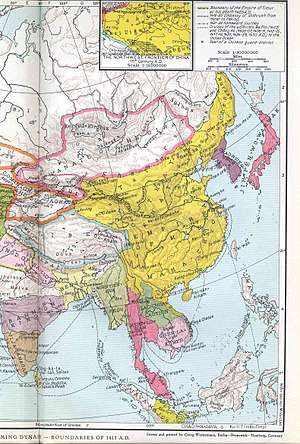
Through the establishment of firm relationship, a Chinese explorer and mariner named Zheng He commanded several expeditions to southeastern Asia between 1405 and 1430 where they visiting Malacca in their third voyage.[16] His accompanier and translator named Ma Huan described the place in his Yingya Shenglan as formerly under Siam before a local king there asserting for independence to become an "Islamised country", and by the time of their fourth imperial fleet visit, he described the local king had just converted and dressed like an Arab with his kingdom are chafing under the Chinese dominance.[17][18] The last edition of official Chinese historical works of Twenty-Four Histories named as History of Ming (Mingshi) made a brief mention of an already established Chinese settlement in the area,[19] followed by other records especially when trade contacts had been established with the Nanyang region.[20] The Words about the Sea (Hai Yü) written by Hwang Chung (Huang Zhong) and published in 1537 gives further account on the life practice of the Chinese community in Malacca which are different than the local Malays.[21]
The connection is well maintained even with the Islamisation of the Malacca and Brunei kingdoms, whose thalassocracy once covered much of the territory of the present-day Malaysia. Both of the Muslim sultanates pledged protection from the Chinese dynasties to shield them from further conquest either by neighbouring Javanese Majapahit or Siamese Ayutthaya.[22][23][24] The close relationship also resulted in the interracial marriage between the Sultanate royal family and Chinese envoy and representatives.[25][26][27] Zheng He's arrival propagated the spread of Islam in the Malay Archipelago and aided the growth of Chinese Muslim population from the eastern China's coastal towns of Fujian and Canton with many of their traders arrived at the coastal towns of present-day Malaysia and Indonesia by the early 15th century.[28][29] Apart from the early settlements in Kinabatangan and Malacca, two other oldest Chinese settlements are located in Terengganu and Penang Island as part of the trade networks with the respective areas.[30][31][32]
Colonial era (1500–1900)
.jpg)
Following the conquest of Malacca by the Portuguese in 1511, many Chinese traders avoided Portuguese Malacca although the flow of emigrants from China continued.[33] The Zhengde Emperor conducted several retaliations against the Portuguese due to their activities in Malacca during the Ming dynasty, following the arrival of her fleet in Canton.[34] However, the Chinese emperor was reluctant to help the deposed Malaccan ruler reclaim his position, as the dynasty's foreign policy was being changed to maintain friendly relations with the Portuguese.[34][35]
His successor, the Jiajing Emperor later changed the attitude of the Ming court by executing two government officials and reaffirming the importance of issues regarding the Malacca in major policy decisions.[35] Regardless, some Chinese from China proper, including those from Fujian, defying Ming dynasty regulation for the sake of trade, informed the Portuguese on the trade route between Guangdong and Siam. The local Malaccan Chinese were not treated favourably by the Portuguese, so they, along with most overseas Chinese, refused to cooperate with the Portuguese.[36] Through the administration of Portuguese in Malacca, Chinese Muslims sided with other Islamic traders against the latter by providing ships and capital.[37] A negotiation was later held in Guangdong regarding the Malaccan issues between the Chinese officials and Portuguese envoys, with Malacca remaining under Portuguese control.[38]
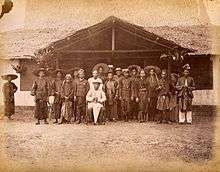
Following the Dutch takeover of Malacca in 1641,[39] many local Malaccan Chinese were hired for the construction of Dutch buildings.[40] The Dutch found the Chinese to be industrious and encouraged the latter's participation in the economic life of the Dutch colony.[41] Under their administration, the Dutch also established a settlement in Perak in 1650 through an earlier treaty with Aceh.[42] The Dutch further suggested the 17th Sultan of Perak, Alauddin, to allow the Chinese to develop tin mines, which was warmly welcomed by the latter. It also facilitated his scheme of requesting more Chinese workers to be sent from Malacca. He promised to punish any official guilty of mistreating the Chinese as well.[43][44]
With the Sultan's consent, the Chinese began playing a leading role in the industry; however, as a result of the Fourth Anglo-Dutch War in 1780, tin trade was adversely affected and many Chinese miners left.[45] Despite the existence of early Chinese settlements in Malacca and several areas along the coasts of the archipelago, the mass migration of Chinese to Malaysia largely occurred after the opening of British settlements in both British Malaya and British Borneo during the early 19th century.[46]
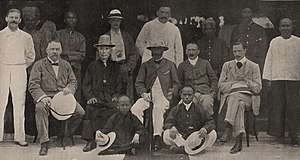
The opening of a British settlement in Penang (1786) and another in Singapore (1819) triggered an emigration from China to the Malay Peninsula.[46] Following the establishment of British rule in Labuan in 1846, more ethnic Chinese, the majority of whom are Hakka and many of them from Singapore, arrived at the British Borneo part of North Borneo. The migration trend continued through the first few years of the establishment of the North Borneo Chartered Company.[47] Chinese migration to both Labuan and North Borneo is largely confined to the agricultural sectors, while in the Raj of Sarawak, they are largely restricted to the mining, as well as the agricultural sectors.[48][49] Rajah Charles Brooke of Sarawak promoted the migration of the Chinese, along with the Dayak, to the interior of Sarawak in order to develop the area. This resulted in the establishment of an administrative centre and a trading centre (bazaar) by the 19th century, primarily in the First, Second and Third Divisions of the country.[50]
In 1876, Rajah Charles further invited Chinese-pepper grower from Singapore to settle in Kuching, which later being joined by local Chinese miners and others from neighbouring Dutch Borneo.[51][52] With the introduction of pepper into the kingdom, the entire pepper cultivation in Sarawak area of Kuching-Serian in the First Division are dominated by the Hakka, while the Foochow and Cantonese dominate the cultivation in Sarikei-Binatang area in the Third Division, making Sarawak the second largest pepper producer in the world.[52][53] Following the British success in gaining direct control on the four states of Perak, Selangor, Negeri Sembilan and Pahang, nearly two million Chinese immigrants entered with half of 1.5 million in both Perak and Selangor.[54][55]
_BHL40563162_(cropped).jpg)
With the further discovery of rich tin deposits in British Malaya, the Chinese immigrants became more involved in the tin mining businesses with many of their labourers work in the industry.[56] With more tin mines opened in Perak, many of the Chinese community in neighbouring Penang also gain profits and become wealthy.[57] By the 1870s, many Chinese tin mining communities had been established in the Malay Peninsula, particularly in Ipoh (Kinta Valley), Taiping, Seremban and Kuala Lumpur (Klang Valley) which is largely dominated by Hakka and Cantonese group.[58][59] Each of the mining communities were governed by a Kapitan Cina with duties and privileges similar as being used in the Kangchu system of Johor.[60] The huge influx of Chinese migration are directly caused by the poverty in rural China and massive employment opportunities in the British colonial or protectorate territories with an estimated of 5 million Chinese had entered by the 19th century and 12 million more despite a total of 17 million later either moved to other parts of Southeast Asia or return to China.[61] Nonetheless with their economic success following the migration, there were also disorder among the Chinese communities as they were divided into different secret societies which in part exarcerbated by political unrest among Malay aristocracy fighting for the right to be chief with each side enlisting help from different Chinese secret societies faction.[60][62] The situation of the local Malay politics at the time are described by observers as plagued with anarchy and civil war between their own kind, prompting alliances of high placed Malay political leaders with the Chinese as well European officials for protection and securing their investments.[63]
Divided nationalism and turbulent era (1900–1945)
—Sun Yat-sen, during his speech at the 1910 Penang conference in the Straits Settlements of Penang.[64]
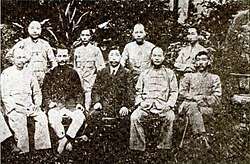
By the 1900s, civil wars and conflicts between the indigenous ethnics began to cease when the British established firm control over both Malaya and northern Borneo despite none of the Malay kingdoms was actually colonised with all the related entities came under political and economic stability as well economic prosperity under the British capital and economic geared up by the Chinese and Indian workforce through the national exploitation of tin and rubber.[61][65] Prior to the 1911 Chinese Revolution that successfully overthrow the Qing dynasty in China, the leader of the Tongmenghui revolt named Sun Yat-sen raise overseas funding and organisational support from overseas Chinese communities mainly from French Indochina, Dutch East Indies, Philippines, Siam, British Singapore, British Malaya and British Borneo with the establishment of Nanyang revolutionary organisation activities in Saigon, Hanoi, Pontianak, Manila, Bangkok, Singapore and George Town.[66] Through the way to transform the current administration of China, a competition raise between three groups who champion the political reformation with each of the group targeted overseas Chinese especially in Malaya and Singapore for their source of support and funds.[67] The first group consists of the pro-Qing elite, who mainly targets wealthy Chinese for funds and expertise to modernise China, while the other two are reformists and revolutionaries who intends to advocated constitutional reforms, introduction of parliamentary system and complete overthrow of Qing and Manchu political influence for a modern Chinese nation.[67]
Following the success of reformists and revolutionaries after the revolution with the establishment of a new Chinese government under the Republic of China, many branches of the Tongmenghui succeeding party of Kuomintang emerged in British Malaya with majority support were first shown by Straits-born Chinese than the China-born.[65] In British Borneo, Kuomintang activities came under the Democratic Party of North Borneo, a body formed by Chinese-educated towkays despite it is not known whether China assisted the activities.[68] The patriotism among Chinese immigrant communities was then entirely focused on China.[69] The British colonial authorities initially do not have problem for any Chinese residing in the two territories becoming Kuomintang members but with the anti-imperialists policy within the organisation, this resulted the British and the new China government unable to maintain a close relationship.[70] By 1925, when a communist movement emerged among the overseas Chinese with the establishment of South Seas Communist Party in colonial Singapore and its subsequent banning, this further leading to the establishment of Indochinese Communist Party, Communist Party of Malaya, Communist Party of Burma and the Communist Party of Siam with the communist movement also maintaining relations with an earlier Southeast Asia Communist Party of Indonesia.[71][72] Prior to the World War II, the Communist Party of Malaya followed the general communists line of opposing Western democracies by intensifying its propaganda against the Malayan government as well the colonial government of Singapore in 1940.[73]
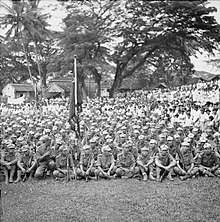
With the beginning of Sino-Japanese conflict and subsequent Japanese occupations of Malaya and British Borneo, further activities by young Kuomintang enthusiasts were shortly stopped.[74] When the Communist Party of China under Mao Zedong reached an agreement with the Kuomintang government under Chiang Kai-shek to put aside their conflict and rally together against Japanese aggression in July 1940, a growth of anti-British led to the banning of Kuomintang and other Chinese organisations in Malaya.[73][75] Nevertheless, with the ensuing conflict with Japan that also involving the British, Chiang Kai-shek urge every Kuomintang members to fight alongside the latter with the British colonial authorities in return announced the lifting of ban towards any Chinese associations including both the Kuomintang and Chinese communist movement as a sign to appreciating the value of co-operation.[76] The leaving of ban and subsequent recognition by the British colonial authorities towards the Communist Party of Malaya as their ally resulted in the formation of the party guerrilla force of Malayan Peoples' Anti-Japanese Army (MPAJA) in 1941.[77] The MPAJA which consisted mainly of ethnic Chinese in Malaya waged a guerrilla war against the Imperial Japanese Army (IJA) throughout Malaya with the movement had a total strength of 10,000 men from eight battalions where they also made contact with the British Force 136 during the war.[78] Some revolt by local Chinese under the influence of the Kuomintang such as the Jesselton uprising in British Borneo occur through the Japanese harsh administration but as similarly happened towards many innocent civilians, they were severely repressed by Japanese secret police of Kenpeitai.[79][80]
In North Borneo, much of the underground anti-Japanese activities by ethnic Chinese is part of the Nanyang Chinese National Salvation Movement led by Tan Kah Kee while in Sarawak most of them operating under the communist-influenced movement of Sarawak Anti Fascist League.[81][82] The victory of the Allies in the Pacific in 1945 led to the disbandment of MPAJA guerrillas in the Malay Peninsula and many of their leading members receiving awards from the British.[83] But even with the disbandment after the war ended, the MPAJA has adopted a radical policy and began to massacring those, mainly Malays who they had considered as collaborators during their war against the Japanese, causing a rising ethnic conflict when the Malays began to retaliated.[84] The MPAJA also targeting British posts with several grenade attacks on British troops.[83] Different situation happened in North Borneo which is under Kuomintang influence when ethnic Chinese there choose to co-operate with the British and being loyal to King George VI towards the formation of the Crown Colony of North Borneo after the war.[85]
Post-turbulent, further emergency and social integration (1946–1962)

—Gerald Templer, following his appointment as British High Commissioner to Malaya to deal with Malayan Emergency in 1952.[86]
With the rebranding of MPAJA to Malayan National Liberation Army (MNLA), attacks by communist insurgents further ensued with their guerrilla tactics in the jungles by sabotaging transportation networks and attacking British plantation sources that resulted in the assassination of several European plantation owners in Malaya.[84] The British intelligence estimate the support for the MNLA was mainly based on around 500,000 from the total of 3.12 million ethnic Chinese living in Malaya by the time and battling the insurgents proved difficult as most of them hid in inaccessible jungles.[87] With the declaration of emergency on 18 June 1948 during the ensuing Malayan Emergency, the early government response was chaotic and disorganised as their primary target is only to guard important economic targets.[88][89] The predominantly nature of the MNLA which consisted entirely from ethnic Chinese making most of the Malays who constituted nearly half of the population of five million in 1950 opposed the movement.[90]
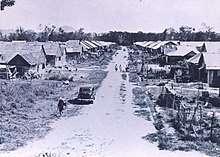
A military plan called Briggs' Plan which devised by British General Harold Briggs are being undertaken shortly in 1950 to protect the population and isolate any connection of involved population from the insurgents which is also followed by the promise for independence, with the latter won majority support from the Malays although the Chinese population need more convincing as they feared on being treated as a "second-class citizens" in an independent Malaya.[92] Among the steps being undertaken under the plan includes the establishment of rapid settlement of squatters under security surveillance, regrouping of labour, minimum level of troops throughout Malaya to support security forces on clearing priority areas and complete accord of operation between police and army with close integration of intelligence.[93] Under the continual resettlement scheme, more than 700,000 rural ethnic Chinese community were corralled into 582 new settlements established by the government around Malaya.[91] With the demise of British colonial administrator Henry Gurney after a sudden ambush by the insurgents in 1951, Gerald Templer are appointed as a new colonial administrator to Malaya by Winston Churchill in the following year with the latter then primarily choose the "hearts and minds campaign" apart from military and psychological measures to combat the insurgents.[87][94][95] As part of his campaign, Templer instituted incentive schemes for surrendering rebels including to those who encouraged them to surrender and used strict curfews and tight control of food supplies from involved areas to flush out the insurgents.[96][97] Crops grown by the insurgents were sprayed with herbicide and defoliants with any of the involved areas that already found to be free from the insurgents will be elevated to "white status" with any previous restrictions were lifted.[98][99][100]
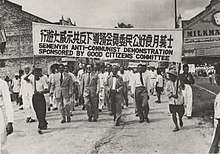
Despite large applause are given for his campaign, the root causes of the campaign success are mainly attributed to the continuous Briggs' Plan as expressed by the leader of the communist side Chin Peng where the massive resettlement of ethnic Chinese villagers resulted in the isolation of the communist movement.[101] Apart from that, the various early moves made by his predecessor Gurney for the introduction of a quasi-ministerial system with a bill to increase the number of non-Malays to be eligible for citizenship in the path towards independence also contributed to the victory.[102] Even with the hearts and minds issued by Templer throughout the war, there were also a massacre named the Batang Kali massacre perpetrated by British security forces against unarmed ethnic Chinese civilians in late 1948.[103] Following the fall of Kuomintang and the establishment of communist control in China in 1949, foreign missionaries in the country were forced by the new communist authorities to leave which then invited by Templer to provide spiritual healing to the residents of the new government-controlled villages in Malaya where they also provide medical education and welfare measures to one-third of the Chinese population.[104] By September 1952, Templer realised the citizenship plan with every people born in Malaya were granted full citizenship which include 1.2 million Chinese within the scheme.[105]
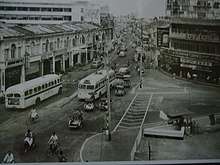
By the time when the Federation of Malaya attained its independence from the British in 1957, there were still conflicts with the communists.[106] The ethnic Chinese communist members who surrendered were given the choice whether they want to be repatriated to China or return to their normal lives by showing their loyalty to the elected government of Malaya and giving up their communist ideology to which they will be helped by the government.[107] The campaign against communists by the newly independent country continued until 1960 when the Malayan government declared the end of state of emergency after Chin Peng decided to abandon its armed struggle with the demobilisation of its armed units thus leaving his hide-out in southern Thailand for Beijing through North Vietnam where he was accommodated by the Chinese authorities in the International Liaison Bureau with medical benefits and monthly allowances.[108][109] Through the meeting between the leader of Malayan communist with high-ranking Chinese communist politician such as Deng Xiaoping in Beijing, China urged them to continue their armed struggle, convincing the Communist Party of Malaya to reverse the policy they had decided earlier.[110] The success of the establishment of a communist government in Mainland China also had great effect on the ethnic Chinese community in Sarawak, especially younger generations when they organised themselves into pro-Beijing friendship society of Sarawak Overseas Chinese Democratic Youth League and following local government vigilance that resulting to its disestablishment, it was re-established into Sarawak Advanced Youths' Association which later culminating into the communist insurgency in Sarawak in 1960.[81] Even the conflicts with communist ensued, the economic situation of Malaya continued to prosper with strong financial position and defined by World Bank as among the most prosperous in Asia with large dependent on tin and rubber industries inherited since the British era which is largely dominated by ethnic Chinese and Indian workforce.[111][112]
Struggle for equality under the proposed Malaysian Malaysia (1963–1965)
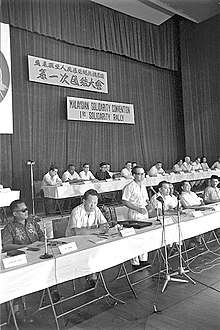
Early in 1961 when Malayan Prime Minister Tunku Abdul Rahman outlined the idea for a "Grand Malaysian Alliance" comprising the British protectorate of Brunei and Crown colonies of North Borneo, Sarawak and Singapore,[113] the leader of Singapore under ethnic Chinese Lee Kuan Yew who is also against the communist movement become the utmost supporter towards the proposal with its party of People's Action Party (PAP) rallying for equality for all future Malaysians, regardless of their "class, skin colour or creed" with equal concept rested on a multi-ethnic society involving each of races in the entities which is not solely to be "Malayised" after the merger.[114][115] Although Lee were seen by Malay extremes in the United Malays National Organisation (UMNO) and Pan-Malaysian Islamic Party (PAS) as being anti towards Malay special rights in the new federation following his criticism towards the unbalanced system between every races after the formation of Malaysia in 1963,[116][117] the Singaporean leader had earlier adopted Malay language as the national language of Singapore and appointed the first Yang di-Pertuan Negara, Yusof Ishak from the Malay ethnicity.[118]
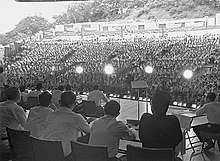
The Malaysian Chinese Association (MCA) as the successor of Malayan Chinese Association and representative of ethnic Chinese in Malay Peninsula led by Tan Cheng Lock which has been part of the Malaysian Alliance Party refused to joined in the struggle for equality as they feared it will disrupted an earlier consensual agreement that has been agreed in Malaya between UMNO and the Malaysian Indian Congress (MIC), in which the Malays hold the country political dominance, the Chinese control the country economic sectors while Indians playing a lesser economic role but within a gradual specific time frame the Malays will later partaking the sharing of economic with the Chinese and Indians partaking some aspects of political power.[119] After two years being part of a newer federation, especially following the controversial enactment of Article 153 to the Constitution of Malaysia, Lee is joined by two parties in the Malay Peninsula, the United Democratic Party led by Lim Chong Eu and People's Progressive Party led by D. R. Seenivasagam as well two from Sarawak such as the Sarawak United Peoples' Party led by Ong Kee Hui and Machinda Party led by Michael Buma to form the Malaysian Solidarity Convention to continuously campaign for equality under Malaysian Malaysia.[116] During his speech at the Malaysian Solidarity Convention meeting in Singapore in June 1965, he expressed the political way based on race and religion currently practised in the Malay Peninsula:
It took a long time for us all to come to the same conclusions despite our differing experience in Malaya, Singapore, Sabah and Sarawak. Our friends in Sabah are not here today officially, but I can assure you that we have many friends there. There is no doubt about it that it took us a long time to reach inevitable conclusion that these people [referring to the racial politics in Malay Peninsula] were up to no good. You know the line they were taking with growing truculence on a heavy racial accent, the intimidatory postures and the snarling guttural notes on which they sent out their signals to their followers on the basis of race lead us to only one conclusion -- that if this goes on, Malaysia will not belong to Malaysians. Since there are so many Malaysians, we decided that the time has come for us to speak our minds.[120]
— Part of Lee Kuan Yew speech at the Malaysian Solidarity Convention in National Theatre, Singapore, June 1965.
Lee's further callings for the re-alignment of forces between those who wanted a "true Malaysian nation" or those who preferred a country led by communal segregation dominated by one of the constituent party from the Alliance together with his attacks on the Malay ultras for their attempts to foster only Malay dominance over the new country of Malaysia has led to a bitter relations between PAP and UMNO which further exaggerated into race riots in Singapore earlier in 1964 and leading to their expulsion from the federation in August 1965.[116][121][122]
Further conflicts and ethnic clashes (1965–1990)
The struggle for equality concept are then being continued by a new party established in the Malay Peninsula shortly after in 1965, the Democratic Action Party (DAP) as PAP successor following the latter expulsion from the federation.[117] Many ethnic Chinese in the Malay Peninsula soon began to perceive their ethnic party representative, the MCA are only concerned with business and economic interests than social factors since the party itself being led by wealthy Chinese with entire decision making fell under the influence of UMNO with persistent reminder by Prime Minister Tunku Abdul Rahman to the whole nation that MCA should be the sole legitimate representative for the ethnic Chinese community in the federation.[117] By 1968, the communists with the support of Mainland China communist government began to gain ground by launching a new insurgency from their stronghold in southern Thailand in the heightened disagreement between the local ethnic Chinese and Malay in local political scene with the issuance of a directive entitled "Hold High the Great Red Banner of Armed Struggle and Valiantly March Forward" by the Central Command of the Communist Party of Malaya with guerrilla attacks on Malaysian security forces resulting to significant amount of success and considerable losses to the latter.[123][124] The following year when the 1969 Malaysian general election being held, MCA faced strong challenges from the new ethnic Chinese representative parties, the DAP together with Malaysian People's Movement Party (GERAKAN). Of the 33 parliamentary seats contested during the election, MCA only managed to retain 13 seats and lost its control over the Penang state government to GERAKAN with subsequent gain by the opposition parties led to further tension between the Chinese and Malay which erupted into the 13 May riots.[125][126] The clashes since then largely affecting the ethnic sentiments between the two groups in Malay Peninsula including in neighbouring Singapore which have similarly enduring clashes early in 1964 when it still part of Malaysia.[127]
In the aftermath of the riots that sent severe shock through the whole Malaysian society, Prime Minister Tunku Abdul Rahman placed the blame entirely on the communists rather than race issues plaguing both the ethnic Chinese and Malay, holding the view that Mainland China communist government was trying to do the similar things with what had been did by Soviet Union to eastern Europe, further in the opinion that the ongoing Vietnam War in their neighbour was "not simply a civil war but communist ideology expansion".[128] Instead of declaring a state of emergency as done by the British authorities previously, the Malaysian government responded by introducing several policy initiatives including the security and development, neighbourhood watch program and the People's Volunteer Group.[129] With the internal conflicts within the Communist Party of Malaya in the 1970s, the group split into two factions of revolutionary in 1970 and Marxist–Leninist in 1974.[130] The communists struggle suffered setbacks when both Kuala Lumpur and Beijing began to established diplomatic relations in 1974 with China ending their aid to the movement, causing the merger between the two separated factions into the Malaysian Communist Party in 1983 before they surrendering to Thai authorities in 1987 following continuous offensives by the latter with subsequent peace agreement between Malaysian authorities and the communists movement in 1989.[65][131] Another communist insurgency by predominantly ethnic Chinese in Sarawak which partly supported by neighbouring Indonesia for their opposition towards the federation of Malaysia also ended through peace negotiations in 1990.[132]
Present situation (1990–present)
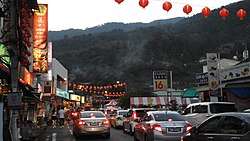
As a legacy of the divide and rule colonial policy imposed since the British administration, the division have lasting impact on the present-day ethnic relations in Malaysia which further exacerbated by agreement between race-based parties formed prior to the country formation.[133] The failure to live under equal concepts has led to "strong identification with Chinese identity" from every ethnic Chinese Malaysians in contrast with what had long been practised by other Southeast Asian Chinese in neighbouring Indonesia, Philippines, Singapore, Thailand and Vietnam.[133][134] In the aftermath of ethnic clashes in 1969 between the Chinese and Malay, the further implementation of Malaysian New Economic Policy favouring the Malays from 1971 until 1990 resulting the increase of Bumiputera economic control by 60%.[135] Nevertheless, since the country foundation even with previous agreement of their limitation in political matters and other controversial policy, ethnic Chinese Malaysian remain the traditional dominant player in the business sector of the Malaysian economy with equity ownership doubled from only 22.8% in 1969 to 45.5% in 1990 and almost every of rich people in the country are dominated by the latter.[136]
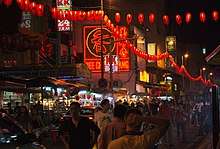
Since ethnic Chinese Malaysians manage the country's economy, most of them reside in urban areas with statistics in 1991 found that about three-quarters (75.8%) mostly living in the country towns and cities.[137] The continual disparity causing many modern ethnic Chinese Malaysian do not normally speak Malay among themselves,[138] in contrast to the earlier ethnic Chinese who had mix with local Malay or other indigenous people such as the Straits-born Chinese of Baba-Nyonya, Kelantanese and Terengganuan Peranakans, Penangite Hokkien and Sabah Sino-Natives.[139][140][141] Ethnic Chinese Malaysian in East Malaysia on both Sabah and Sarawak, especially in small inland towns also interact more closely with indigenous people there with the absence of significant language and religious barrier which further resulted in more interracial marriage among them.[141] Major issues of integration in modern Malaysian nation as a whole today is largely inherited from the past Malayan racial politics especially when contacts between ethnics are only made between several sub-communities which eventually consolidated into a single political community.[142] The discriminate affirmative policy and hierarchy continually practised in Malaysia's modern education system and workplace in the 21th century further causing the brain drain trends among young educated and talented ethnic Chinese Malaysian to different developed countries.[143][144] Despite the rising brain drain among the youth, the country also saw the latest wave of newer ethnic Chinese Mandarin-speaking immigrants from northeastern China, and another from new small mixture with Vietnamese since 2000s following the increasing small number of ethnic Chinese Malaysian, especially men marrying foreign wives from Mainland China and Vietnam.[145]
Origins and social demographics
Since their early ancient trade connection and subsequent migrations, the majority of ethnic Chinese in Malaysia are mostly from ethnic Han from the historical areas of Fujian and Guangdong provinces in southern China.[146] Nearly all ethnic Chinese Malaysians living in the country today are either patrilineal descendants of these early immigrants, or new immigrants born in mainland China.[147] Among the first group from the first migration wave are the Peranakans in Kelantan and Terengganu, Sino-Natives in Sabah and Straits-born Chinese (Baba-Nyonya) in Malacca and Penang.[139][140][148] The Taiping Rebellion in the mid-19th century caused much chaos and suffering in southern China, which leading many ethnic Chinese civilians to sought refuge overseas, particularly to Nanyang region in further south.[149] With the expanding British colonial economies in the region which led to the establishment of Straits Settlements, more migrants were attracted and primary become the important destination for Chinese emigration.[149]
By the late 19th century with the second wave of migration through the British colonial rule, the Hokkien of southern Fujian led by many of their wealthy and powerful individuals with skills in finance and maritime shipping became the dominant immigrant group as the first group of ethnic Chinese to settle in large numbers with their language become a contact language among Chinese of different linguistics background.[150] The Cantonese from Canton in Guangdong follow suit and became well known as mineworkers, land reclamation, mechanics and their familiarity with cash cropping.[151][152] Another large group, the Hakka are mostly hill farmers originated from northeastern Guangdong and various southern China places who specialise in forest clearance, mining as well on metalworking.[151][152] Other groups like the Teochew from Chaozhou of eastern Guangdong are mainly on plantation agriculture,[151][152] the Foochow from central Fujian specialise in entrepreneurship,[153] while the Hainanese from Hainan as one of the ethnic Chinese minority saw themselves as sojourners with many of Hainanese chefs and waiters ruled the kitchen of local Chinese kopi tiam and restaurants.[154][155] The Henghua and Hokchia from eastern Fujian are usually managing family industries while the Kwongsai from Guangxi are employed in labour sectors.[156][157] Followed by the third wave of ethnic Chinese migration thereafter, this resulted Malaysia as being one of the country outside China and Taiwan with largest population of Chinese speakers in the world.[145][158] Following the establishment of diplomatic relationship between Mainland China and Malaysia in 1974, a joint communiqué was made between the two nations, which stated:
The Chinese government considers anyone of Chinese origin who has taken up his own will or acquired Malaysian nationality as automatically forfeiting Chinese nationality. As for residents who retain Chinese nationality of their own will, the Chinese government, acting in accordance with its consistent policy, will enjoin them to abide by the law of the Government of Malaysia, respect the customs and habits of the people there, and live in unity with them, and their proper rights and interests will be protected by the Government of China and respected by the Government of Malaysia.[159]
Ethnic distributions
| Year | Pop. | ±% |
|---|---|---|
| 1970 | 3,555,879 | — |
| 1980 | 4,554,664 | +28.1% |
| 1991 | 4,623,900 | +1.5% |
| 2000 | 5,691,908 | +23.1% |
| 2010 | 6,392,636 | +12.3% |
| Note: Main census is released every ten years. Source: Malaysian Population Statistics | ||
The first census conducted in 1970 after Malaysia was formed in 1963 reported that there were 3,555,879 ethnic Chinese Malaysians, with the Hokkien or Min Nan (福建人 or 闽南人) being the majority at 32.4%, followed by Hakka (客家人) at 22.1%, Cantonese (广府人) at 19.8%, Teochew (潮汕人) and Hainanese (海南人) at 12.4% and 4.7% respectively.[160] This increase to 4,554,664 in 1980 and 4,623,900 in 1991.[161] In 2000, the census reported that ethnic Chinese Malaysians numbered at 5,691,908, which was approximately 24.45% of the country's population at the time, with 86% of them living in urban areas.[149] In West Malaysia, Hokkien became the leading group followed by Cantonese, Hakka and Teochew.[162] The pattern differs in East Malaysia where Hakka is the majority in Sabah and Sarawak followed by Hokkien and Cantonese in Sabah and the Foochow (福州人), Hokkien and Teochew in Sarawak.[163][164][165] In 2010, the population increase further to 6,392,636.[166]
The Hokkien are notably prominent in the states of Johor, Kedah, Kelantan, Malacca, Penang, Perlis, Sarawak, Labuan and Terengganu while the Hakka is prominent in Sabah and the second largest sub-group in Labuan.[167] The Cantonese are mostly concentrated in the cities of Kuala Lumpur and Ipoh, and to some extent in Bera, Kuantan, Bentong, Lipis, Mersing, Raub, Cameron Highlands, Jerantut, Temerloh, Bahau, Kampar, Rompin, Gopeng, Maran, Tapah, Pekan, Bidor and Seremban as well as Sandakan and Keningau (Taishanese or 台山人) in Sabah and Sarikei in Sarawak.[167] The Teochew are mostly in Johor and coastal Perak.
The Foochows are numerous in Yong Peng, Sitiawan, Sungai Pelek, Bintangor, Sarikei and Sibu.[167][168] The population of Hainanese can be found in all cities and towns in Malaysia, numerously in Malacca and Terengganu together with the smaller population of Kwongsais or Guangxi (广西人) in Pahang and Henghuas or Putian (兴化人 or 莆田人) and Hockchia or Fuqing (福清人) in various other areas.[167]
There is also a small community of Huáběi-ren (Northern Chinese or 华北人) in Sabah whose ancestors coming from various parts of Hebei (河北) and Shandong (山东) provinces in China with most of them calling themselves as Tiānjīn-ren (天津人 or 津侨). Besides that, Sanjiang-ren (Chinese: 三江人) is a collective term used to categorise the group of people whose ancestors hailed from Shanghai (上海), Zhejiang (浙江), Jiangsu (江苏), Hubei (湖北) and Jiangxi (江西). It is a sub group of mixed spoken dialects and has the fewest people as compared to other Chinese sub groups. The first San Jiang Clansmen Association or San Kiang Association was formed in Penang back in 1897.[169][167]
Although the ethnic Chinese population had been increasing since the 1970s, their proportion within the total population had been decreasing gradually, particularly caused by the lower birth rate among the Chinese community.[160]
Economic and political representation
Ethnic Chinese Malaysians have been traditionally dominant in the business sector of the Malaysian economy with large local Chinese enterprises involved in natural resources and food ingredients industries such as sugar and palm oil.[170] Almost every biscuits manufacturers in the country also dominated by ethnic Chinese Malaysians.[171] Up to the 1970s, their economic structure was interwined with very much family and kinship ties.[172] By the 21st century with the rising of China's economic influence, their economy network are jointly connected with other Overseas Chinese through the bamboo network.[173] The local Chinese played a key role in facilitating China's capital to invest in Malaysia while in the process both benefited from expanded markets, lower labour costs and the introduction of different kind of technologies and managerial systems which resulted Malaysia becoming the largest trading partner to China in Association of Southeast Asian Nations (ASEAN) region.[174] Nevertheless, unlike the more trans-boundary business influence by neighbouring Chinese Singaporeans, a majority of Chinese Malaysians businesses are still seen as less concentrating on developing business ties with other Southeast Asian Chinese businessmen despite there have been few business made by several local Malaysian Chinese companies.[175]

Since the country's foundation in 1963, the Malaysian Chinese Association (MCA) had become the sole legitimate political representation for ethnic Chinese in Malaysia under the multi-racial political coalition of the Alliance Party (later expanded into National Front coalition).[176] The growing restriction of non-Malay interests in Malaysian society and politics since the 1970s, however, caused a deep dissension among Chinese Malaysians. There grew a wide perception that their ethnic party representatives were unable to stand for their people's rights, and that decision-making was influenced by the Malay supremacists dominated party of United Malays National Organisation (UMNO). The UMNO were part of the existing political coalition, and also championed Islamic values.[177] Despite the coalition's multi-racial appearance, UMNO founding president Onn Jaafar has once said that their movement did not adhere to any ideology other than "Malayism", defined by Malay scholar Ariffin Omar as the belief that the interests of the Malay race must be upheld over anything else.[178] Until 1968, the inability of MCA to preserve ethnic Chinese Malaysian interests, particularly with regards to their culture, education and language, resulted in the formation of another ethnic Chinese representative party, the Malaysian People's Movement Party (GERAKAN) led by Chinese overseas-educated elite, although this party also joined the Alliance Party coalition in 1972.[179]
With the growing Islamisation with "Islamic version of non-tolerant and open" as well increasing racism within the Malay party members throughout the coalition administration which further being imposed into the country social demographics causing further disenchantment among non-Malays especially ethnic Chinese together with the government discriminal policies on their education and employment.[180] This subsequently causing dwindle support from ethnic Chinese Malaysians when many Chinese constituents which are originally the stronghold of MCA turned to the Democratic Action Party (DAP) as the latter were seen as more vocal on their rights.[181][182][183] The recent country general election in 2018 saw the fall of National Front coalition following additional aid from Bornean parliamentary seats particularly in Sabah that were won by Pakatan Harapan coalition ally of regionalist Sabah Heritage Party (WARISAN) as well from another indigenous party of United Pasokmomogun Kadazandusun Murut Organisation (UPKO) as a result of similar growing frustration over long-time manipulation of the state demographics and resources with lack of development through the administration of the Malay-led supremacists government of UMNO with frequent labelling as "fixed deposit state".[184][185][186] During the election, the DAP won large amount of seats in many Chinese constituents and subsequently diminish MCA influence among ethnic Chinese Malaysians.[187][188][189]
Contributions towards local medical practice
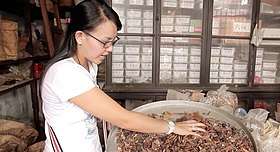
Aside from their economic dominance, ethnic Chinese Malaysians are known for their contribution in the country healthcare sectors with their traditional health practice. Around 3,000 medicine shops in the country sell traditional Chinese medicine with development support also given by the country Health Ministry.[190] Chinese traditional health practice services in the country generally encompass the zhong yi (Chinese medicine), qigong (health), chiropractic care, acupuncture and several others.[191] In 2012, the Traditional and Complementary Medicine Bill (T&CM) was passed by the Parliament of Malaysia for the establishment of "Traditional and Complementary Medicine Council" to register and regulate traditional and complementary medicine practitioners, including traditional Chinese medicine practitioners as well Malay, indigenous and Indians traditional medicine which followed by the enforcement of T&CM Act in the following year.[192] Since most of the traditional medicine pharmacies are family-apprentice trade, most of the traditional medicine practitioners are not registered as a doctor under the health department despite support given by the Health Ministry with most can practice the career without needed to be registered under government law.[190]
Education
In educational aspects, Malaysia is the only country outside China and Taiwan with a comprehensive and complete Chinese education system and the only Southeast Asian country that has perpetuated the Chinese education system established since the colonial era as a result of heavy brokerage and lobbying efforts by ethnic Chinese Malaysians political leaders with continual funding from local Chinese communities.[193][194] The first Chinese schools had been established in the country in the 19th century during the British colonial administration.[195][196][197] At the same time, Christian missions from China also founded schools for Chinese students to nurture Church workers, this are most notable among many Chinese Christians of Hakka origin in Sabah and the Foochow in Sarawak.[198] Following the country's independence, some of the Chinese independent schools who were influenced by the new national agenda and desperately needed government financial support were willingly converted into English medium-schools. However, these schools were later scrupulously converted into Malay medium-schools following the massive elimination of English medium-schools by the Malay-dominated regime in the 1970s in an effort to impose the Malay language as the only medium of instructions in all schools in the aftermath of ethnic riots in 1969.[193][194] The following period was considered a dark time for local Chinese education, and witnessed a growing belief in the idea that the ethnic Chinese in Malaysia had to proceed on a basis of self-reliance and vigilance in order to preserve their language rights as the national education policy was seen as exclusionary and discriminatory for non-Malays, summed up in the aphorism "non-Malays belong to Malaysia but Malaysia only belongs to the Malays".[193][199]

Although other remaining Chinese independent schools were also included in the national school system in 1996, these independent schools still did not receive any financial assistance from the federal government and its United Examinations Certificate (UEC) is not recognised by the government, making students who finishing their studies from the local Chinese independent schools unable to enroll in government-funded public tertiary institutions.[200] Since the late 1970, ethnic Chinese Malaysians had expanded their own Mandarin-language primary schools where around 90% of their children were enrolled based on the figures from 2006.[201] These schools gained reputation for not only maintaining good discipline but also providing the high-quality education that the Malay schools were seen by some to lack. This perceived superiority attracted a significant interest among Bumiputera parents with various analyses placing the number of Bumiputera students enrollment in Chinese schools between 60,000–100,000 in 2000.[201] The federal government's failure to impose Malay as the sole unifying language throughout the country's educational systems unlike in China with Standard Chinese or Indonesia with Indonesian language are mainly attributed to the racial-based policy enforcement of ethnic inclusion and exclusion.[202] Some argue that the educational policies imposed by the federal government over the years in regard to minority language education have created negative consequences for Malaysian youth: a mounting brain drain in particular. A study from 2000 found that the country had lost an ample amount of talented and skilled youth to other more favourable countries as the result of students form the large non-Malay minority language communities being forced to go to university abroad because they did not attend Malay language schools.[203][204]
Culture
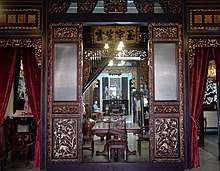
Chinese cultural influences made their mark when ancient trade relations were established with the Nanyang (南洋) region.[205] The massive ethnic Chinese migration during the British colonial period causing a subsequent strong influence on the country culture, including in cuisine and the language.[206] Aside from the Chinese cultural influence on local culture, ethnic Chinese from the first wave migration before English arrival had mainly adopted a localised culture.[207] The Baba-Nyonya in Malacca had a very strong Malay influence in their clothing and food although still maintaining their Chinese heritage of religion, name and identity.[208] Their food are made with Malay ingredients and recipes but produced using Chinese method while their houses are constructed with the infusion of Victorian, Chinese and Malay elements.[208] Together with the Peranakans in Penang, both sides use a mixture of Hokkien and Malay despite the Penang Peranakans speak mainly Hokkien with some borrowed words from Malay words while in Malacca, the Peranakans have adopted Malay patois with some Hokkien words.[209] The food prepared by Penang Peranakans also infuses both Chinese and Malay elements, albeit with an additional Thai influence.[209] The Peranakans in east coast of Malaysia in Kelantan and Terengganu have a much closer ties with the Malay and Siamese community there since most of them has adopted the Malay and Siamese lifestyle.[210][211][212]
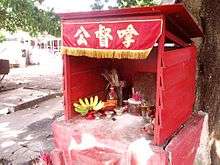
A further close blood relations between ethnic Chinese and local indigenous in northern Borneo since the early kingdoms period produced the "Sino-Natives" persons in Sabah as a result of inter-marriage between ethnic Chinese there and natives of Sabah.[213] Instead of speaking Chinese languages, these community spoke the localised Sabah Malay dialect as their main lingua franca since the 14th century.[213] The close relations is mark with earliest records of "Kina" term which is widely used by the indigenous Dusun to refer the Chinese ethnicity including for the Dusun homeland mountain of "Mount Kinabalu" (Chinese widow mountain), "Kinabatangan River" (Chinese river) and several other places such as the Kinabalu mountain stream of "Kinataki", a small river in northeastern coast of "Kinabañgun" and a Chinese land in Labuan Island, the "Kinabenua".[214][215] The Na Tuk Kong shrine for example shown another sign of assimilation with local culture, where it refers to local Malay guardian spirits worshipped by some ethnic Chinese in West Malaysia and neighbouring Singapore and Indonesia.[216] The term Na Tuk originated from the Malay word of Datuk (grandfather) which then merged with Kong (公, sometimes addressed as 'Kung' meaning elderly male), similar with Tu Ti Kung (Chinese: 土地公), an earth deity worshipped in East Asia.[217][218]
Cuisine

The ethnic Chinese cuisine in Malaysia is derived from the culinary traditions of their early immigrants and descendants, who have adapted or modified their culinary traditions under the influence of Malaysian culture as well as immigration patterns of Chinese to the country where Chinese cuisine has now become an inseparable part from the country cultural mixture.[219] When Chinese merchants sailed their junks across the South China Sea, they visiting ports in Borneo and Malacca which then have profound influence in the region.[219] Chinese traders who visited Borneo always brought some good cooks with them since the local king in the island are very much liked Chinese food.[220] They introduced ingredients in Chinese cooking such as noodles, bean sprouts, tofu and soy sauce which is now widely used by every ethnic groups in the country.[221] Apart from introducing, these earlier traders also discovering worth ingredients among the local population along the coast, such as the expensive edible bird's nest with the best nests are claimed to come from Borneo than in China.[222][223] Since a vast majority of Chinese Malaysians today are descendants of immigrants from southern China, local Chinese cuisine roots is predominantly based from Fujian, Cantonese, Hakka and Teochew cuisines. Their technique of stir frying a portion of food ingredients in a little cooking oil over high heat in a wok (锅) are widely adopted.[221]
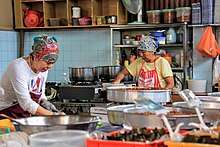
Chinese Malaysians cuisine developed a strong penchant of spices and chillies where any local Chinese kopi tiam or restaurant will offer pickled green or red chillies sambal for noodles and rice-based meals.[221] They borrowed curry leaves from the Indians and have since adapted English Worcestershire sauce and tomato sauce along with Indian and Malay spices to the cooking pot.[221] Among the notable Chinese dishes in the country including the bak kut teh (肉骨茶) (pork rib soup with Chinese herbs), char kway teow (炒粿条) (stir fried rice noodle), dim sum (点心) (ready-to-serve dishes), hae mee (虾面) (spicy prawn noodle soup served in savoury broth), Hainanese chicken rice (海南鸡饭), kai si hor fun (鸡丝河粉) (flat rice noodle soup with chicken slices, shrimps and bean sprouts), kolok or kolo mee (干捞面) (Sarawakian egg noodle served in dark sauce, tomato sauce or chilli sauce), lor mee (卤面) (thick yellow noodle served in dark sauce and thick broth), ngiu chap mee (牛杂面) (special Sabah mixed beef noodle), pan mee (板面) (handmade noodle soup served with pork balls, minced pork, dried anchovies, black fungus and vegetable), sang nyuk mee (生肉面) (special Sabah dry pork noodle or pork noodle soup), wonton mee (云吞面) (dry noodle or noodle soup served with BBQ pork, minced pork and pork or shrimp dumplings) and yong tau foo (酿豆腐) (tofu and mixed vegetables filled with ground pork mixture or fish paste). Many Chinese Malaysians also can cook Malay-style chicken or fish with most versions of laksa (叻唦) are prepared by them.[221] Some examples of basic Chinese Malaysians drinks commercially produced in the country including the black tea, chrysanthemum tea, grass jelly, green tea, jasmine tea, soy milk and white coffee while popular snacks including the cakoi (油炸鬼) (long deep-fried dough), egg tart, hum ji peng (咸煎饼) (circle shaped fried dough with or without fillings), ngoi sing tart (外星塔) (UFO shaped tart), ngo hiang (炸五香) (various spiced, minced meat rolls prepared in deep fried style and served with vegetables), pau (包) (steamed buns), popiah (薄饼) (fried or plain spring rolls filled with mixed vegetables), and tau sar piah (豆沙饼) (pastry biscuits filled with a sweet or savoury filling).[224] The legacy from the first wave migration created the Peranakan (土生华人) (including the Baba-Nyonya (峇峇娘惹)) ethnicity through a blend between Chinese and Malay which subsequently produced the Peranakan cuisine where they served Indian-style curries with eating etiquette different than mainstream ethnic Chinese society by following the Malay usage of fingers than chopsticks.[225] The Baba-Nyonya also specialised in making variety of local snacks called kuih which require plenty of patience and skills.[226]
Dialects and languages

| Loanword | English description |
|---|---|
| bihun/mihun | rice vermicelli |
| cakoi | a long deep-fried dough |
| cawan | cup |
| cincai | carelessly, in a hurry, random |
| cincau | grass jelly |
| ginseng | root of herbal plants |
| kapcai | underbone motorcycle |
| kuaci | sunflower seed |
| kuetiau | rice noodle |
| kuih | snack and dessert |
| longkang | drainage |
| mee/mi | noodle |
| pau | steamed bun |
| popia/popiah | fried spring roll |
| samseng | gangster |
| tauhu | tofu |
| tauke | big boss |
| teh | tea |
| tongkang | ancient Chinese sailing ship |
| Source: Asmah 1975, p. 40 and DBP | |
The 1970 Malaysian Census reported the Southern Min dialects being the largest which accounting for 34.2% of the country Chinese population, followed by Hakka with 22.1%, Cantonese by 19.8%, Chaozhou (Teochew) by 12.4% and Hainanese by 4.7%.[160] In 2003, a more detailed statistics for each dialects reported the Hokkien with 2,020,914, Hakka with 1,092,835, Cantonese with 1,068,008, Teochew with 497,280, Foochow with 251,553, Hainanese with 141,045, Kwongsai with 51,674, Henghua with 24,654, Hockchia with 14,935 and different other ethnic Chinese with 202,977, for a total of 5,365,875.[149] The Malaysian Hokkien are divided into two localised dialects; the Penang Hokkien (northern) comprising Kedah, Penang, Perak and Perlis and Southern Peninsular Hokkien in Johor, Malacca and neighbouring Singapore.[227] The northern Hokkien contains more Malay loanwords than the southern with the latter maintaining more of their original Hokkien words.[227] Many Hokkien living in Sarawak have been influenced heavily by indigenous language similarly with Hokkien in Kelantan where their language were heavily localised following close interaction with local Malays and Siamese.[227] Localised Hokkien also spoken primarily by the Peranakan community (Baba-Nyonya) in both Malacca and Penang.[228] Generally, Hokkien became a contact language among ethnic Chinese of different linguistic background in most parts of Malaysia.[229]
The Malaysian Cantonese became the contact language in the Malaysia's capital of Kuala Lumpur albeit with a distinct phonology and grammar from standard Cantonese spoken in Pearl River Delta region of China including in Hong Kong and Macau.[229][230][231] Hakka dialect assumes the role of contact language in Sabah but in the rest of the country the language are more commonly used as an intra-group language than a lingua franca within the Chinese community with about 66.2% of Hakka in Johor prefer localised Mandarin.[232][233] Similar studies on Eastern Min speakers of Foochow community in Sarawak also found a general shift of language choice from their own dialect to Mandarin Chinese and English.[234] The Chaozhou dialect despite being not a largest dialect group has become a bridge language for trade between Teochew exporters in China and wholesalers in Malaysia.[235][236] Hainan dialect is another minority and the sub-dialect of the Min Chinese dialect family although it is treated in the country as an independent dialect.[237] Several others like Henghua are also generally termed as "dialects", which in fact together with the rest are variety of Chinese languages from different Chinese ethnicity.[238] Mandarin, which is generally spoken by northern Chinese minority in Sabah become the main working language among all Chinese in the country with Standard Mandarin is used as the medium of instruction in local Chinese medium school and independent high school although the language still not necessarily spoken in their daily life practice.[239] Based on early Malaysian Census in 1970, around 41% of ethnic Chinese Malaysians able to converse in Mandarin.[240]
Holidays and festivities

With the large presence of ethnic Chinese in the country nationwide, the ethnic main festivity of Chinese New Year have been gazetted as a national public holiday with 11 states and three federal territories in the country celebrate the festive with two days holidays while two remaining states of Kelantan and Terengganu only celebrate a one-day holiday.[241] During the New Year, many Chinese living with their family in the urban areas will celebrate the festive together while some who may have family in rural areas will return for family reunions. A traditional dinner with entire family are the most important aspect on the celebration where there will also be a traditional food tossing culture of yee sang especially among the Cantonese.[242][243] The elder one will usually give the young a red envelope (ang pow or angpau) with variety of festival sweets are presented in the house for visitors. Most Chinese settlements and Chinatown streets will be decorated early before the New Year with colourful lanterns and lamps that will be shined at night throughout the festive. The performances of dragon and lion dances will be presented throughout every Chinese settlements in the country with firecracker and fireworks shows also featured at night as part of the celebrations.[243]
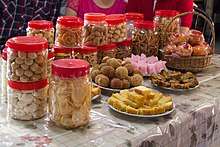
Chingay procession are also being held as part of the New Year festivities especially in Johor Bahru and Penang.[244] Several other festivals are celebrated through the seasons in a year including the Dongzhi Festival, Dragon Boat Festival, Hungry Ghost Festival, Lantern Festival (Chap Goh Mei), Mid-Autumn Festival, Nine Emperor Gods Festival and Qingming Festival which originated from much of Chinese folk beliefs and traditional agricultural society.[245] Throughout the festivals, especially for major Chinese festivals such as the New Year, Hungry Ghost and Mid-Autumn, nearly every Chinese temples including charity temples in the country will organise cultural and religious activities.[246] The Hungry Ghost Festival is generally not observed by most Dejiao (Zi) group in Malaysia which descended directly from Dejiao association in China, it is only mainly observed by three Zi associations in Kuala Lumpur (Zi Fang Ge), Pulau Ketam (Zi Bang Ge) and Butterworth (Zi Wei Gi) with the three calling the festival as Wanyuan Shenghui than Yulan Shanghui.[247] The Mooncake Festival are popularly celebrated through the Mid-Autumn Festival where there will be the exchange and consume of mooncake as well lantern festival.[248] Traditional Chinese weddings remain popular to some ethnic Chinese Malaysians couple even most have preferred the Western-influenced wearing of white wedding dresses and black jackets.[249]
Religion
Based on the 2000 Malaysian Census, 86.6% of ethnic Chinese Malaysians follow Buddhism of Mahāyāna branch and Chinese folk religion with Chinese temples and shrines are visible nationwide.[251] A more detailed statistics in 2010 found a total of 5,341,687 ethnic Chinese Malaysians of Buddhists adherents, 706,479 are Christians, 218,261 practising Confucianism, Taoism and other Chinese folk religion, 49,320 were irreligious, 42,048 are Muslims, 14,878 are Hindus, 11,387 with unknown religion while 8,576 practising other different religion.[250] Among the common deities worshipped by ethnic Chinese Malaysians in temples are Lord Guan (Guangong Shengjun), Guan Yin (Goddess of Mercy), Dabo Gong (Earth God) and Mazu (Goddess of Heaven).[251]
Commonly found in ethnic Chinese homes and shops are altars installed for deities of their choice together with ancestors worship. Most of the deities are Chinese origin but it is still uncommon to sight a few of local deities.[251] There are different types of Chinese Buddhist temples and societies in every Malaysian cities and towns with only Buddhist statues, although some may have one or two other Chinese deities.[251] Other Buddhist branches of Theravāda and various Tibetan traditions (Vajrayāna) also have Chinese members where it is not surprising that some of the other Buddhist branches buildings are build with the fund and philanthropic efforts of local Chinese Buddhists as exampled from the establishment of Buddhist Maha Vihara in Kuala Lumpur and Wat Chayamangkalaram in Penang.[251][252][253] Unlike the institutional religion of Buddhism, Christian and Islam, ethnic Chinese who follow traditional folk religion do not have separate name for their belief and practices which is similar to the country indigenous people such as Iban and the Orang Asli.[254] They describe their religious belief as either bai shen or bai fo (deities worshipping) which include the worshipping of Buddha since Mahayana Buddhist deities are also commonly worshipped by the followers of Chinese traditional religion.[254]
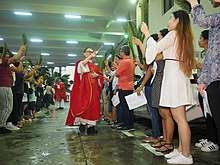
Chinese Christians, including both Catholic and Protestants presence is mainly visible with their active missionary activities especially among ethnic Chinese in East Malaysia with large proportion than other regions.[255] The majority of Christians in West Malaysia also are of Chinese origin.[256] Most early Chinese churches including Baptists, Methodists and Presbyterians have their origin from missionaries migrants who introduced the missions established in China to Malaysia.[251] The number of Chinese Muslims are very small compared to Chinese Christians since the latter religion are seen as more tolerance and accepting, mainly due to the general perception that embracing Islam in Malaysia is like to become Malayised in addition to the ethnic rivalry between Malay and Chinese that makes Islam as less desirable to ethnic Chinese Malaysians.[251] A majority of Chinese Malaysians, especially those who have received Chinese education, following Confucian values and to a lesser extent with Taoism while their ordinary people who are less educated expressing in their view of filial piety and social relations, consulting Chinese horoscopes as well on Chinese geomancy of feng shui.[251] Taoist activities gain increasing interests and significance among Chinese Malaysians although it is not deeply practised.[257][258]
See also
Notes
- Of the 8,820 Malaysian-born people resident in New Zealand in 1991, only 1,383 were Malay; most of the rest were Chinese Malaysians. In the 2013 New Zealand census, 16,350 people were born in Malaysia. Of these, more than five-eighths gave their ethnicity as Chinese or Malaysian Chinese. The next most numerous were Malays, with smaller groups of Indians and other Asian peoples.[5]
Footnotes
- Department of Information Malaysia 2015.
- Department of Statistics Malaysia 2016.
- Department of Infrastructure and Regional Development Australia 2016, p. 2.
- Department of Statistics Singapore 2010, p. 31.
- Walrond 2015.
- Dorall 2020.
- Gabaccía & Hoerder 2011, p. 218.
- World Bank 2011, p. 12.
- Defillippi, Arthur & Lindsay 2009, p. 117
• Fong & Zubair 2017, p. 15
• Jakobsen 2014, p. 170
• Tyson 2018, p. 55 - Andaya 1982, p. 17
• Zepp 1989, pp. 19–21
• Wong 1999, p. 132
• Munoz 2006, p. 178
• Lee 2013, p. 542
• Wan et al. 2013, pp. 7–11 - Royal Society (Great Britain) 1924, p. 157.
- Runciman 2011, p. 11.
- Wong 1998, p. 2.
- Guillot, Lombard & Ptak 1998, p. 162.
- Runciman 2011, p. 14.
- Brezina 2016, p. 58.
- Ma, Huan & Feng 1970, p. 109.
- Gordon 2007, p. 133.
- Tan 1988, p. 29.
- Purcell 1947, p. 115–125.
- Groeneveldt 1876, p. 7.
- Cohen 2000, p. 175.
- Ma & Cartier 2003, p. 79.
- de Vienne 2015, p. 42–43.
- Ma & Cartier 2003, p. 90.
- Lee 2010, p. 11.
- Ooi 2015, p. 50.
- Ember, Ember & Skoggard 2004, p. 115.
- Ma 2017, p. 11.
- Lee 1965, p. 306–314.
- Wong 2016, p. 9–21.
- Wade & Chin 2018, p. 249.
- Guillot, Lombard & Ptak 1998, p. 179.
- Zhang 1934, p. 67.
- Wade & Chin 2018, p. 144.
- Guillot, Lombard & Ptak 1998, p. 179
• Wernham 1968, p. 543
• Kratoska 2001a, p. 101
• Borschberg 2004, p. 12 - Borschberg 2004, p. 12.
- Wade & Chin 2018, p. 145–146.
- Blussé 2009, p. 23.
- Lim & Fernando 2006, p. 126.
- Ramanathan 1994, p. 67.
- Chisholm 1911, p. 479.
- Khoo & Lubis 2005, p. 5.
- anon. 2014, p. 210.
- Khoo 1972, p. 39.
- Hirschman 1986, p. 338.
- Wong 1999, p. 132.
- Geography of British Colonies 1864, p. 31.
- Niew 1969, p. 2.
- Drabble 2000, p. 86.
- Gurney 1986, p. 268.
- Bulbeck et al. 1998, p. 68.
- Kaur 2016, p. 48.
- Doran & Dixon 1991, p. 111.
- Kratoska 2001b, p. 209.
- Yat 1969, p. 57.
- Douw, Huang & Ip 2013, p. 165.
- Tin Industry (Research and Development) Board 1955, p. 9.
- Lin & Hill 1979, p. 145.
- Landa 2016, p. 58.
- Ching & McKenna 1990, p. 2.
- Comber 1956, p. 146–162.
- Peletz 1996, p. 102.
- Khoo 2008, p. 55.
- Khoo 2010.
- de Ruffé 1928, p. 124
• Harris 1956, p. 98
• Png 1961, pp. 1–32
• Journal of the Siam Society 1974, p. 44
• Suryadinata 2006, p. 122
• Lai & Lee 2011, p. 247 - Khoo 2008, p. 24.
- Borneo Research Council 1977, p. 114.
- Wang 1964, p. 141.
- Hak 2000, p. 69.
- Kennedy 1957, p. 213.
- Hara 2016, p. 12–13.
- Tay 2018.
- Journal of South-East Asian History 1961, p. 224.
- Wang 1964, p. 144.
- Cheah 2013, p. 37.
- Suryadinata 2012, p. 136.
- Wong 2002a.
- Thurman & Sherman 2001, p. 123.
- Tay 2016.
- der Kroef 1964, p. 50–60.
- Wong 2001, p. 93–105.
- Hartfield 2012, p. 350.
- Kantowicz 2000, p. 111.
- Kalgoorlie Miner 1946.
- Lapping 1985, p. 224.
- David & Joe 2009.
- Leifer 2013, p. 110.
- Ong 2014, p. 87.
- Hack 1999, p. 99–125.
- Yamada 2004, p. 225–231.
- Chaliand 1982, p. 272.
- Hamby 2002, p. 59.
- Stubbs 2004, p. 1.
- Ramakrishna 2013, p. 139.
- Nolan 2011, p. 248.
- Comber 2015, p. 100.
- Ooi 2004, p. 830.
- Jackson 2008, p. 49.
- Hamblin 2013, p. 175.
- Gentile 2013, p. 52.
- Tarling 1992, p. 376.
- Hale 2013, p. 432.
- Roy & Saha 2016, p. 68.
- Roy & Saha 2016, p. 67.
- Great Britain. Colonial Office 1957, p. 469.
- Great Britain. Colonial Office 1957, p. 4.
- Singh 2014, p. 39.
- Garver 2015, p. 200.
- Singh 2014, p. 41.
- Gomes 2007, p. 46.
- World Bank 2010.
- Bunnell 2004, p. 76.
- Purushotam 2000, p. 209.
- Josey 2013, p. 153.
- Cheah 2002, p. 54.
- Akbarzadeh & Saeed 2003, p. 142.
- Tan 2004b, p. 42.
- Ooi 2004, p. 55.
- National Archives of Singapore 1965, p. 1.
- Diamond, Plattner & Chu 2013, p. 187.
- Reid 2015, p. 362.
- Razak 2015, p. 69.
- Ong 2014, p. 95.
- Charles & Cheng 1971, p. 47.
- der Kroef 1981, p. 107.
- Kua 2007, p. 74.
- Cheng 2009, p. 66.
- Nazar 2005, p. 19–20.
- Chin 2003, p. 467–468.
- Chin 2003, p. 450.
- Porritt 2004, p. 279.
- Tong 2010, p. 95.
- Chen 2004, p. 66.
- Gomez 2012, p. 1.
- Ooi 2004, p. 55
• Gomez 2012, p. 2
• Jesudason 1997
• Malott 2011 - Kam & Tan 2000, p. 78.
- Wang & Wang 1998, p. 31.
- Tan 2004, p. 93–95.
- Wong 2004, p. 55.
- Tong 2010, p. 110.
- Enloe 1968, p. 372–385.
- Jakobsen 2014, p. 170.
- Tyson 2018, p. 55.
- Samantha 2016.
- Simon 1996, p. 51.
- Tan 1997, p. 103–116.
- Oxford Business Group 2008, p. 12.
- Ember, Ember & Skoggard 2004, p. 698.
- Gosling & Lim 1983, p. 89
• Menkhoff 1993, p. 47
• Kuhn 2008, p. 47
• Wurm, Mühlhäusler & Tryon 2011, p. 698 - Reid & Rodgers 2001, p. 82.
- Kuhn 2008, p. 47.
- Kaur 2016, p. 194.
- Tan 2002, p. 20.
- Sharp 2008, p. 1.
- Malaysian Historical Society 1969, p. 34.
- Douw & Post 1996, p. 148.
- Asmah 2004, p. 52.
- Camilleri 1975, p. 27.
- Wang 2012, p. 12.
- Yamaguchi & Deterding 2016, p. 4.
- Kam & Tan 2000, p. 39.
- Kam & Tan 2000, p. 47.
- T'ien 1983, p. 278.
- Yong 2013, p. 291.
- Department of Statistics Malaysia 2010a, p. 15.
- Ember, Ember & Skoggard 2004, p. 699.
- Lee & Suryadinata 2012, p. 114.
- Penang San Kiang Association 2020.
- Voon 2007, p. 234.
- May 2015.
- Voon 2007, p. 195.
- Weidenbaum & Hughes 1996, p. 47.
- Wong & Tan 2017, p. 113.
- Gomez 2012, p. 185.
- Cartier 2011, p. 71.
- Strauch 1981, p. 37
• Weiner & Özbudun 1987, p. 136
• Teck 1988, p. 18
• The Coverage 2019 - Ting 2009, p. 35.
- Jenkins 2008, p. 91.
- Weiner & Özbudun 1987, p. 136
• Bakri 2007, p. 232
• Joseph & Nadirsyah 2010, p. 94
• Lahoud & Johns 2012, p. 177
• The Coverage 2019 - Weiner & Özbudun 1987, p. 136.
- Coplin 1991, p. 9.
- Case 2013, p. 105.
- Sipalan & Menon 2018.
- The Borneo Post 2019.
- Stephanie 2018.
- Cheng & Faris 2018.
- Dayley 2018, p. 203.
- Sukumaran 2019.
- Stevenson, Tai & Yuan 2014, p. 282.
- Beh 2017.
- Ministry of Health Malaysia 2015, p. 10.
- Curdt-Christiansen & Hancock 2014, p. 145.
- Ang 2017.
- Kam & Tan 2000, p. 230.
- Wong 2002b, p. 35.
- Charney, Yeoh & Tong 2003, p. 147.
- Ting 2011, p. 38
• Charney, Yeoh & Tong 2003, p. 147
• Bays 1996, p. 165
• Goh 2005, p. 52 - Kee, Hill & Yin 2016, p. 75.
- Kee, Hill & Yin 2016, p. 77.
- Nelson, Meerman & Rahman 2008, p. 201.
- Kee, Hill & Yin 2016, p. 78.
- Defillippi, Arthur & Lindsay 2009, p. 117.
- Fong & Zubair 2017, p. 15.
- Barbie J. 1992.
- Nazri et al. 2017.
- Kee & Choong 2006, p. 83.
- The Star 2008.
- Government of Penang.
- Winzeler 1974, p. 45–61.
- Nazri, Hanapi & Teo 2011, p. 112.
- Carolyn 2015.
- Zhang 2018, p. 141.
- St. John 1863, p. 327.
- Whitehead 1893, p. 155.
- Lin 2017, p. 126.
- Hock 1996, p. 8.
- Lin 2017, p. 125–126.
- Hutton 2012, p. 24.
- Yuan 2000, p. 19.
- Hutton 2005, p. 13.
- Chen 1976, p. 42.
- Dunlop 1994, p. 251.
- Tan 2012, p. 137.
- West 2010, p. 486.
- Arokiasamy 2017, p. 451.
- Armstrong, Armstrong & Mulliner 2012, p. 218.
- Cheung & Tan 2007, p. 171.
- Wurm, Mühlhäusler & Tryon 2011, p. 698.
- Asmah 2004, p. 51.
- Bauer & Benedict 2011, p. 281.
- Wang 2012, p. 80.
- Platt, Weber & Ho 1983, p. 50.
- Ball 2009, p. 240.
- Ma & Cartier 2003, p. 85.
- Hamilton 2011, p. 124.
- Wang 2012, p. 18.
- Asmah 1992, p. 26.
- Kam & Tan 2000, p. 56
• Maya 2006, p. 73
• Wurm, Mühlhäusler & Tryon 2011, p. 698
• Wang 2012, pp. 16–17
• Suryadinata 1989, p. 166 - Wang 2012, p. 16–17.
- Government of Malaysia 2019.
- Leong 1992, p. 2.
- DK Travel 2016, p. 34.
- Fodor & Fisher 1986, p. 297.
- Jaime & Stephanie 2009, p. 132.
- Tan 2018, p. 103.
- Tan 1985, p. 72.
- DK Travel 2016, p. 59–60.
- Ruby 2014.
- Department of Statistics Malaysia 2010b, p. 15.
- Ember, Ember & Skoggard 2004, p. 703.
- Khoo 2012, p. 313.
- Tan 2018, p. 35.
- Tan 2018, p. 8.
- West 2010, p. 485–486.
- Goh 2005, p. 55.
- Pas 1998, p. 36.
- Khoo 2014, p. 2.
References
Academic publications and journal
- Purcell, Victor (1947). "Chinese Settlement in Malacca". Journal of the Malayan Branch of the Royal Asiatic Society. 20 (1): 115–125. JSTOR 41560007.CS1 maint: ref=harv (link)
- Comber, Leon (1956). "Chinese Secret Societies in Malaya; an Introduction". Journal of the Malayan Branch of the Royal Asiatic Society. 29 (1): 146–162. JSTOR 41503202.CS1 maint: ref=harv (link)
- Png, Poh Seng (1961). "The Kuomintang in Malaya, 1912-1941". Journal of Southeast Asian History. 2 (1): 1–32. doi:10.1017/S0217781100100377. JSTOR 20067317.CS1 maint: ref=harv (link)
- der Kroef, Justus M. van (1964). "Communism and the Guerrilla War in Sarawak". The World Today. 20 (2): 50–60. JSTOR 40393581.CS1 maint: ref=harv (link)
- Lee, Y. L. (1965). "The Chinese in Sabah (North Borneo)". Erdkunde. 19 (4): 306–314. doi:10.3112/erdkunde.1965.04.05. JSTOR 25640360.CS1 maint: ref=harv (link)
- Enloe, Cynthia H. (1968). "Issues and Integration in Malaysia". Pacific Affairs, University of British Columbia. 41 (3): 372–385. doi:10.2307/2755005. JSTOR 2755005.CS1 maint: ref=harv (link)
- Niew, Shong Tong (1969). "The Population Geography of the Chinese Communities in Malaysia, Singapore and Brunei" (PDF). University of London. Archived from the original (PDF) on 18 April 2019 – via SOAS Research Online.CS1 maint: ref=harv (link)
- Winzeler, Robert L. (1974). "Ethnic Complexity and Ethnic Relations in an East-Coast Malay Town". Southeast Asian Journal of Social Science. 2 (1/2): 45–61. doi:10.1163/080382474X00040. JSTOR 24490070.CS1 maint: ref=harv (link)
- T'ien, Ju-k'ang (1983). "The Chinese of Sarawak: Thirty Years of Change" (PDF). CSEAS Journal. 21 (3). Archived from the original (PDF) on 30 April 2019 – via Southeast Asian studies.CS1 maint: ref=harv (link)
- Hirschman, Charles (1986). "The Making of Race in Colonial Malaya: Political Economy and Racial Ideology" (PDF). Cornell University. 1 (2): 330–361. JSTOR 684449. Archived from the original (PDF) on 17 April 2019 – via University of Washington.CS1 maint: ref=harv (link)
- Zepp, Raymond (1989). "The Chinese in Sarawak". Nouvelle Série, Bulletin de Sinologie (53): 19–21. JSTOR 43436606.CS1 maint: ref=harv (link)
- Barbie J. (1992). "Chinese culture and demographic trends in Thailand and Malaysia". Chinese Journal of Population Science. 4 (2): 139–48. PMID 12317919.CS1 maint: ref=harv (link)
- Tan, Chee Beng (1997). "Chinese Identities in Malaysia". Southeast Asian Journal of Social Science. 25 (2): 103–116. doi:10.1163/030382497X00194. JSTOR 24492399.CS1 maint: ref=harv (link)
- Jesudason, James V. (1997). "Chinese Business and Ethnic Equilibrium in Malaysia". Development and Change. 28: 119–141. doi:10.1111/1467-7660.00037.CS1 maint: ref=harv (link)
- Wong, Danny Tze-Ken (1999). "Chinese Migration to Sabah Before the Second World War". Archipel. 58 (58): 131–158. doi:10.3406/arch.1999.3538.CS1 maint: ref=harv (link)
- Hack, Karl (1999). ""Iron Claws on Malaya": The Historiography of the Malayan Emergency". Journal of Southeast Asian Studies. 30 (1): 99–125. doi:10.1017/S0022463400008043. JSTOR 20072108.CS1 maint: ref=harv (link)
- Wong, Danny Tze-Ken (2001). "Anti-Japanese Activities in North Borneo before World War Two, 1937-1941". Journal of Southeast Asian Studies. 32 (1): 93–105. doi:10.1017/S0022463401000042. JSTOR 20072301.CS1 maint: ref=harv (link)
- Wong, Heng (2002a). "Malayan People's Anti-Japanese Army". Archived from the original on 23 April 2019 – via National Library Board, Singapore. Cite journal requires
|journal=(help)CS1 maint: ref=harv (link) - Hamby, Joel E. (2002). "Civil-Military Operations [Joint Doctrine and the Malayan Emergency]" (PDF). Archived from the original (PDF) on 23 April 2019 – via Defense Technical Information Center. Cite journal requires
|journal=(help)CS1 maint: ref=harv (link) - Yamada, Yuumi (2004). "マレーシア華人新村の成立背景とその概要 : 華人新村研究 その1" [The Historical Setting of the Chinese New Villages in Malaysia : A study on the development of Chinese new villages in Malaysia Part I] (in Japanese). 69 (585). doi:10.3130/aija.69.225_2. Cite journal requires
|journal=(help)CS1 maint: ref=harv (link) - Nazar, Talib (2005). "Malaysia's Experience In War Against Communist Insurgency And Its Relevance To The Present Situation In Iraq" (PDF). Archived from the original (PDF) on 26 April 2019 – via Defense Technical Information Center. Cite journal requires
|journal=(help)CS1 maint: ref=harv (link) - Ting, Helen (2009). "The Politics of National Identity in West Malaysia: Continued Mutation or Critical Transition? [The Politics of Ambiguity]". Southeast Asian Studies, Kyoto University. 47 (1). Archived from the original on 9 May 2019 – via J-STAGE.CS1 maint: ref=harv (link)
- Khoo, Kay Kim (2010). "Reflections on Malaysia–China Relations: 1874 – 1974". Centre for Malaysian Chinese Studies. Archived from the original on 20 April 2019. Cite journal requires
|journal=(help)CS1 maint: ref=harv (link) - World Bank (2010). "Malaya - The economy of the federation of Malaya (English)": 1–55 – via World Bank. Cite journal requires
|journal=(help)CS1 maint: ref=harv (link) - Nazri, Ahmad; Hanapi, Dollah; Teo, Kok Seong (2011). "Penghayatan Tradisi Lisan Melayu dalam kalangan Masyarakat Cina Kelantan" [Appreciation of Malay Oral Traditions among the Chinese in Kelantan] (PDF). Malay Journal (in Malay) (8). Archived from the original (PDF) on 9 May 2019 – via Universiti Kebangsaan Malaysia.CS1 maint: ref=harv (link)
- World Bank (2011). "Malaysia Economic Monitor [Brain Drain]" (PDF). Archived from the original (PDF) on 10 May 2019 – via World Bank. Cite journal requires
|journal=(help)CS1 maint: ref=harv (link) - Khoo, Salma Nasution (2012). "Exploring Shared History, Preserving Shared Heritage: Penang's Links to a Siamese Past [The Siamese community and Buddhism in Penang]" (PDF). Journal of the Siam Society. 100. Archived from the original (PDF) on 23 March 2019 – via Siamese Heritage Trust.CS1 maint: ref=harv (link)
- Wan, Kong Ann; Mair, Victor H.; Roberts, Paula; Swofford, Mark (2013). "Examining the Connection Between Ancient China and Borneo Through Santubong Archaeological Sites" (PDF). Department of East Asian Languages and Civilizations, University of Pennsylvania. ISSN 2157-9687. Archived from the original (PDF) on 20 April 2019 – via Sino-Platonic Papers.CS1 maint: ref=harv (link)
- Kee, Cheok Cheong; Hill, Christopher; Yin, Ching Leong (2016). "Malaysia's Education Policy and the Law of Unintended Consequences". Journal of International and Comparative Education. 5 (2): 73–86. doi:10.14425/jice.2016.5.2.73. ISSN 2232-1802.CS1 maint: ref=harv (link)
- Wong, Danny Tze-Ken (2016). "Early Chinese Presence in Malaysia as Reflected by three Cemeteries (17th-19th c.)". Archipel (92): 9–21. doi:10.4000/archipel.280.CS1 maint: ref=harv (link)
- Tay, Frances (2016). "Japanese War Crimes in British Malaya and British Borneo 1941–1945". Japanese War Crimes Malaya Borneo. Archived from the original on 6 October 2017.CS1 maint: ref=harv (link)
- Hara, Fujio (2016). "The Malayan Communist Party as Recorded in the Comintern Files" (PDF). Archived from the original (PDF) on 22 April 2019 – via ISEAS–Yusof Ishak Institute. Cite journal requires
|journal=(help)CS1 maint: ref=harv (link) - Ang, Ming Chee (2017). "Chinese Education in Malaysia" – via Oxford Research Encyclopedias. Cite journal requires
|journal=(help)CS1 maint: ref=harv (link) - Nazri, Raji; Shahrim, Karim; Farah, Ishak; Mursyid, Arshad (2017). "Past and present practices of the Malay food heritage and culture in Malaysia". Journal of Ethnic Foods. 4 (4): 221–231. doi:10.1016/j.jef.2017.11.001.CS1 maint: ref=harv (link)
- Fong, Terry; Zubair, Hassan (2017). "Factors Contributing Brain Drain in Malaysia" (PDF). International Journal of Education, Learning and Training. 2 (2). Archived from the original (PDF) on 6 May 2019.CS1 maint: ref=harv (link)
- Tan, Lee Ooi (2018). "Buddhist Maha Vihara during Colonial Times [Chapter 1 – Introduction]" (PDF). Archived from the original (PDF) on 1 April 2019 – via Asian Studies Centre, Thailand. Cite journal requires
|journal=(help)CS1 maint: ref=harv (link) - Tay, Shereen (2018). "Communist Party of Malaya". Archived from the original on 23 April 2019 – via National Library Board, Singapore. Cite journal requires
|journal=(help)CS1 maint: ref=harv (link)
Government source
- National Archives of Singapore (1965). "Text of Mr. Lee Kuan Yew's Speech at the Malaysian Solidarity Convention at the National Theatre on 6th June 1965" (PDF). National Archives of Singapore. Archived from the original (PDF) on 25 April 2019.CS1 maint: ref=harv (link)
- Department of Statistics Malaysia (2010a). "Total population by age group, sex, ethnic group, stratum and state, Malaysia" (PDF). Department of Statistics, Malaysia. Archived from the original (PDF) on 6 May 2019.CS1 maint: ref=harv (link)
- Department of Statistics Malaysia (2010b). "Total population by ethnic group, religion, sex and state, Malaysia" (PDF). Department of Statistics, Malaysia. Archived from the original (PDF) on 6 May 2019.CS1 maint: ref=harv (link)
- Department of Statistics Singapore (2010). "Census of Population 2010 [Table A6 Resident Population by Place of Birth, Ethnic Group and Sex]" (PDF). Department of Statistics, Singapore. Archived from the original (PDF) on 16 October 2016.CS1 maint: ref=harv (link)
- Walrond, Carl (2015). "Malaysians and Singaporeans". Te Ara: The Encyclopedia of New Zealand, Ministry for Culture and Heritage, New Zealand. Archived from the original on 1 February 2019.CS1 maint: ref=harv (link)
- Department of Information Malaysia (2015). "Unjuran Populasi Penduduk 2015" [Population Projection for 2015] (in Malay). Department of Information, Ministry of Communications and Multimedia, Malaysia. Archived from the original on 12 February 2016.CS1 maint: ref=harv (link)
- Ministry of Health Malaysia (2015). "Traditional and Complementary Medicine (T&CM) Act [What Should You Know?]" (PDF). Traditional and Complementary Medicine Division. Ministry of Health, Malaysia. Archived from the original (PDF) on 14 May 2019.CS1 maint: ref=harv (link)
- Department of Infrastructure and Regional Development Australia (2016). "Census: Christmas Island" (PDF). Department of Regional Australia, Regional Development and Local Government. Archived from the original (PDF) on 13 May 2019.CS1 maint: ref=harv (link)
- Department of Statistics Malaysia (2016). "Current Population Estimates, Malaysia, 2014 - 2016". Department of Statistics, Malaysia. Archived from the original on 12 August 2016.CS1 maint: ref=harv (link)
- Government of Malaysia (2019). "Jadual Hari Kelepasan Am Persekutuan" [Federal Public Holidays Schedule] (PDF) (in Malay). Cabinet Division, Constitution and Inter-Governmental Relations, Prime Minister's Department, Malaysia. Archived from the original (PDF) on 11 May 2019.CS1 maint: ref=harv (link)
- Government of Penang. "Peranakan". Government of Penang. Archived from the original on 9 May 2019.CS1 maint: ref=harv (link)
News and magazines
- Kalgoorlie Miner (1946). "British North Borneo Becomes Crown Colony [Loyal Addresses]". Kalgoorlie Miner – via Trove.CS1 maint: ref=harv (link)
- The Star (2008). "The Baba Nyonya culture". The Star.CS1 maint: ref=harv (link)
- David, Koh; Joe, Choo (2009). "Remembering Templer". The Star.CS1 maint: ref=harv (link)
- Malott, John R. (2011). "The Price of Malaysia's Racism". The Wall Street Journal.CS1 maint: ref=harv (link)
- Ruby, Lim (2014). "Traditional Chinese wedding for couple". The Star.CS1 maint: ref=harv (link)
- May, Chiam (2015). "All-Malaysian biscuit company bakes its way to the top". The Star.CS1 maint: ref=harv (link)
- Carolyn, Hong (2015). "The Peranakans of Terengganu". The Straits Times.CS1 maint: ref=harv (link)
- Samantha, Khor (2016). "The Origins Of The Hokkien, Cantonese, And Other Chinese Dialect Groups In Malaysia". Says.com.CS1 maint: ref=harv (link)
- Beh, Behonce (2017). "Modernised TCM gains wider audience". Focus Malaysia. Archived from the original on 14 May 2019.CS1 maint: ref=harv (link)
- Sipalan, Joseph; Menon, Praveen (2018). "Sabah no longer a 'fixed deposit' in election for Malaysia's Najib, says party rebel". Reuters.CS1 maint: ref=harv (link)
- Cheng, Kenneth; Faris, Mokhtar (2018). "In big blow to BN, stronghold states fall to opposition, key party leaders ousted". Today.CS1 maint: ref=harv (link)
- Stephanie, Lee (2018). "Upko's Madius leaves Barisan; joins Warisan to form coalition government". The Star.CS1 maint: ref=harv (link)
- Sukumaran, Tashny (2019). "Racial politics: where it all went wrong for the Malaysian Chinese Association?". South China Morning Post. AsiaOne. Archived from the original on 10 May 2019.CS1 maint: ref=harv (link)
- The Borneo Post (2019). "DAP Sabah won't forget Warisan despite PPBM entry". The Borneo Post.CS1 maint: ref=harv (link)
- The Coverage (2019). "It's UMNO's Racism & Discrimination Policies Against Chinese & Indian : Not Vernacular Schools That Destroy National Unity". The Coverage.my.CS1 maint: ref=harv (link)
- Dorall, Anne (2020). "Is it "Malaysian Chinese" or "Chinese Malaysian"?". The Rakyat Post. Archived from the original on 12 July 2020.CS1 maint: ref=harv (link)
- Penang San Kiang Association (2020). "History of Penang San Kiang Association [The early years]". Penang San Kiang Association. Archived from the original on 12 July 2020.CS1 maint: ref=harv (link)
Print
- St. John, Spenser (1863). Life in the Forests of the Far East. Smith, Elder and Company. p. 327.
kina batangan chinese.
CS1 maint: ref=harv (link) - Geography of British Colonies (1864). Geography of the British colonies and dependencies. Publisher not identified.CS1 maint: ref=harv (link)
- Groeneveldt, Willem Pieter (1876). Notes on the Malay Archipelago and Malacca. W. Bruining.CS1 maint: ref=harv (link)
- Whitehead, John (1893). Exploration of Mount Kina Balu, North Borneo. Gurney and Jackson.
On the left hand is the curious mountain of Saduc Saduc, the Anak Kina Balu (child of Kina Balu) of the Dusuns.
CS1 maint: ref=harv (link) - Chisholm, Hugh (1911). The Encyclopaedia Britannica: A Dictionary of Arts, Sciences, Literature and General Information. [Cambridge] University Press.CS1 maint: ref=harv (link)
- Royal Society (Great Britain) (1924). Proceedings of the Royal Society of London: Containing papers of a Biological character. Royal Society.CS1 maint: ref=harv (link)
- de Ruffé, Reginald d' Baron Auxion (1928). Is China Mad?. Kelly & Walsh.CS1 maint: ref=harv (link)
- Zhang, Tianze (1934). Sino-Portuguese Trade from 1514 to 1644: A Synthesis of Portuguese and Chinese Sources. Brill Archive. GGKEY:0671BSWDRPY.CS1 maint: ref=harv (link)
- Tin Industry (Research and Development) Board (1955). What Tin Mining Means to Malaya. Tin Industry (Research and Development) Board.CS1 maint: ref=harv (link)
- Harris, George Lawrence (1956). North Borneo, Brunei, Sarawak (British Borneo). Human Relations Area Files.CS1 maint: ref=harv (link)
- Great Britain. Colonial Office (1957). Federation of Malaya: Report. H.M. Stationery Office.CS1 maint: ref=harv (link)
- Kennedy, Malcolm Duncan (1957). A Short History of Communism in Asia. Weidenfeld & Nicolson.CS1 maint: ref=harv (link)
- Journal of South-East Asian History (1961). Papers on Malayan History: Papers Submitted to the ... International Conference of South-East Asian Historians. Journal of South-East Asian History.CS1 maint: ref=harv (link)
- Wang, Gungwu (1964). Malaysia: A Survey. F.A. Praeger.CS1 maint: ref=harv (link)
- Wernham, R. B. (1968). The New Cambridge Modern History: Volume 3, Counter-Reformation and Price Revolution, 1559-1610. CUP Archive. ISBN 978-0-521-04543-8.CS1 maint: ref=harv (link)
- Yat, Hoong Yip (1969). The Development of the Tin Mining Industry of Malaya. University of Malaya Press.CS1 maint: ref=harv (link)
- Malaysian Historical Society (1969). Malaysia in History. Malaysian Historical Society.CS1 maint: ref=harv (link)
- Ma, Huan; Huan, Ma; Feng, Chengjun (1970). 瀛涯勝覧: 'The Overall Survey of the Ocean's Shores' [1433]. CUP Archive. ISBN 978-0-521-01032-0.CS1 maint: ref=harv (link)
- Charles, T. Goh; Cheng, Teik Goh (1971). The May Thirteenth Incident and Democracy in Malaysia. Oxford University Press.CS1 maint: ref=harv (link)
- Khoo, Kay Kim (1972). The Western Malay States, 1850-1873: the effects of commercial development on Malay politics. Oxford University Press.
The Chinese were already playing a leading role in the industry, but war with the Dutch in the 1780s adversely affected the tin trade because many of the Chinese miners left the state.
CS1 maint: ref=harv (link) - Journal of the Siam Society (1974). The Journal of the Siam Society. Journal of the Siam Society.CS1 maint: ref=harv (link)
- Camilleri, Joseph A. (1975). Southeast Asia in China's Foreign Policy. Institute of Southeast Asian. GGKEY:10PX1CT790B.CS1 maint: ref=harv (link)
- Asmah, Omar (1975). Essays on Malaysian Linguistics. Institute of Language and Literature, Ministry of Education, Malaysia.CS1 maint: ref=harv (link)
- Chen, Esther (1976). Introductory Traditional Chinese Regional Cuisine. The Author.CS1 maint: ref=harv (link)
- Borneo Research Council (1977). Borneo Research Bulletin. Borneo Research Council.CS1 maint: ref=harv (link)
- Lin, Sien Chia; Hill, Ronald David (1979). South-East Asia, a systematic geography. Oxford University Press. ISBN 978-0-19-580398-3.CS1 maint: ref=harv (link)
- Strauch, Judith (1981). Chinese Village Politics in the Malaysian State. Harvard University Press. ISBN 978-0-674-12570-4.CS1 maint: ref=harv (link)
- der Kroef, Justus Maria Van (1981). Communism and South-east Asia. Macmillan International Higher Education. ISBN 978-1-349-16462-2.CS1 maint: ref=harv (link)
- Andaya, Barbara Watson (1982). History Of Malaysia. Macmillan International Higher Education. ISBN 978-1-349-16927-6.CS1 maint: ref=harv (link)
- Chaliand, Gérard (1982). Guerrilla Strategies: An Historical Anthology from the Long March to Afghanistan. University of California Press. ISBN 978-0-520-04443-2.CS1 maint: ref=harv (link)
- Platt, John; Weber, Heidi; Ho, Mian Lian (1983). Singapore and Malaysia. John Benjamins Publishing. ISBN 90-272-8021-5.CS1 maint: ref=harv (link)
- Gosling, Lee Anthony Peter; Lim, Linda Y. C. (1983). The Chinese in Southeast Asia. Maruzen Asia. ISBN 978-9971-954-10-9.CS1 maint: ref=harv (link)
- Tan, Chee Beng (1985). The Development and Distribution of Dejiao Associations in Malaysia and Singapore: A Study on a Chinese Religious Organization. Institute of Southeast Asian. ISBN 978-9971-988-14-2.CS1 maint: ref=harv (link)
- Lapping, Brian (1985). End of Empire. St Martin's Press. ISBN 978-0-312-25071-3.CS1 maint: ref=harv (link)
- Fodor, Eugene; Fisher, Robert C. (1986). Fodor's South-East Asia. D. McKay Company.CS1 maint: ref=harv (link)
- Gurney, Gene (1986). Kingdoms of Asia, the Middle East, and Africa: an illustrated encyclopedia of ruling monarchs from ancient times to the present. Crown. ISBN 978-0-517-55256-8.CS1 maint: ref=harv (link)
- Weiner, Myron; Özbudun, Ergun (1987). Competitive Elections in Developing Countries. Duke University Press. ISBN 0-8223-0766-9.CS1 maint: ref=harv (link)
- Tan, Chee Beng (1988). The Baba of Melaka: culture and identity of a Chinese peranakan community in Malaysia. Pelanduk Publications. ISBN 978-967-978-155-7.CS1 maint: ref=harv (link)
- Lim, Teck Ghee (1988). Reflections on Development in Southeast Asia. Institute of Southeast Asian Studies. ISBN 978-9971-988-99-9.CS1 maint: ref=harv (link)
- Suryadinata, Leo (1989). The Ethnic Chinese in the ASEAN States: Bibliographical Essays. Institute of Southeast Asian Studies. ISBN 978-981-3035-11-9.CS1 maint: ref=harv (link)
- Ching, Fatt Yong; McKenna, R. B. (1990). The Kuomintang Movement in British Malaya, 1912-1949. NUS Press. ISBN 978-9971-69-137-0.CS1 maint: ref=harv (link)
- Doran, Charles F.; Dixon, Chris (1991). South East Asia in the World-Economy. Cambridge University Press. ISBN 978-0-521-31237-0.CS1 maint: ref=harv (link)
- Coplin, William D. (1991). Political Risk Yearbook, 1991: Asia & the Pacific. Political Risk Services. ISBN 978-1-85271-157-3.CS1 maint: ref=harv (link)
- Leong, Gregory (1992). Festivals of Malaysia. Pelanduk Publications (M). ISBN 978-967-978-388-9.CS1 maint: ref=harv (link)
- Asmah, Omar (1992). The Linguistic Scenery in Malaysia. Institute of Language and Literature, Ministry of Education, Malaysia. ISBN 9789836224033.CS1 maint: ref=harv (link)
- Tarling, Nicholas (1992). The Cambridge History of Southeast Asia: Volume 2, The Nineteenth and Twentieth Centuries. Cambridge University Press. ISBN 978-0-521-35506-3.CS1 maint: ref=harv (link)
- Menkhoff, Thomas (1993). Trade Routes, Trust and Trading Networks: Chinese Small Enterprises in Singapore. Verlag Breitenbach. ISBN 978-3-88156-589-9.CS1 maint: ref=harv (link)
- Dunlop, Fiona (1994). Fodor's Exploring Singapore & Malaysia. Fodor's Travel Publications. ISBN 9780679026662.CS1 maint: ref=harv (link)
- Ramanathan, Indira (1994). China and the Ethnic Chinese in Malaysia and Indonesia: 1949-1992. Sangam Books Limited. ISBN 978-0-86132-337-1.CS1 maint: ref=harv (link)
- Bays, Daniel H. (1996). Christianity in China: From the Eighteenth Century to the Present. Stanford University Press. ISBN 978-0-8047-3651-0.CS1 maint: ref=harv (link)
- Weidenbaum, Murray L.; Hughes, Samuel (1996). The Bamboo Network: How Expatriate Chinese Entrepreneurs are Creating a New Economic Superpower in Asia. Simon and Schuster. ISBN 978-0-684-82289-1.CS1 maint: ref=harv (link)
- Hock, Tong Cheu (1996). Malay Keramat, Chinese Worshippers: The Sinicization of Malay Keramats in Malaysia. Department of Malay Studies, National University of Singapore. ISBN 978-981-00-8755-5.CS1 maint: ref=harv (link)
- Douw, Leo; Post, Peter (1996). South China: state, culture and social change during the 20th century. North-Holland.CS1 maint: ref=harv (link)
- Peletz, Michael G. (1996). Reason and Passion: Representations of Gender in a Malay Society. University of California Press. ISBN 978-0-520-20070-8.CS1 maint: ref=harv (link)
- Simon, Roger D. (1996). The City-building Process: Housing and Services in New Milwaukee Neighborhoods, 1880-1910. American Philosophical Society. ISBN 978-0-87169-865-0.CS1 maint: ref=harv (link)
- Tze-Ken, Danny Wong (1998). The Transformation of an Immigrant Society: A Study of the Chinese of Sabah. Asean Academic. ISBN 978-1-901919-16-5.CS1 maint: ref=harv (link)
- Guillot, C.; Lombard, Denys; Ptak, Roderich (1998). From the Mediterranean to the China Sea: Miscellaneous Notes. Otto Harrassowitz Verlag. ISBN 978-3-447-04098-3.CS1 maint: ref=harv (link)
- Bulbeck, David; Reid, Anthony; Tan, Lay Cheng; Yiqi, Wu (1998). Southeast Asian Exports Since the 14th Century: Cloves, Pepper, Coffee, and Sugar. Institute of Southeast Asian Studies. ISBN 978-981-3055-67-4.CS1 maint: ref=harv (link)
- Pas, Julian F. (1998). Historical Dictionary of Taoism. Scarecrow Press. ISBN 978-0-8108-6637-9.CS1 maint: ref=harv (link)
- Wang, Ling-chi; Wang, Gungwu (1998). The Chinese Diaspora: Selected Essays. Times Academic Press. ISBN 978-981-210-092-4.CS1 maint: ref=harv (link)
- Yuan, Bingling (2000). Chinese Democracies: A Study of the Kongsis of West Borneo (1776-1884). Research School of Asian, African, and Amerindian Studies, Universiteit Leiden. ISBN 978-90-5789-031-4.CS1 maint: ref=harv (link)
- Hak, Ching Oong (2000). Chinese Politics in Malaya, 1942-55: The Dynamics of British Policy. Universiti Kebangsaan Malaysia. ISBN 978-967-942-505-5.CS1 maint: ref=harv (link)
- Kam, Hing Lee; Tan, Chee Beng (2000). The Chinese in Malaysia. Oxford University Press. ISBN 978-983-56-0056-2.CS1 maint: ref=harv (link)
- Kantowicz, Edward R. (2000). Coming Apart, Coming Together. Wm. B. Eerdmans Publishing. ISBN 978-0-8028-4456-9.CS1 maint: ref=harv (link)
- Drabble, John (2000). An Economic History of Malaysia, c.1800-1990: The Transition to Modern Economic Growth. Palgrave Macmillan UK. ISBN 978-0-230-38946-5.CS1 maint: ref=harv (link)
- Purushotam, Nirmala (2000). Negotiating Multiculturalism: Disciplining Difference in Singapore. Walter de Gruyter. ISBN 978-3-11-015680-5.CS1 maint: ref=harv (link)
- Cohen, Warren I. (2000). East Asia at the Center: Four Thousand Years of Engagement with the World. Columbia University Press. ISBN 978-0-231-10109-7.CS1 maint: ref=harv (link)
- Reid, Anthony; Rodgers, Kristine Alilunas (2001). Sojourners and Settlers: Histories of Southeast China and the Chinese. University of Hawaii Press. ISBN 978-0-8248-2446-4.CS1 maint: ref=harv (link)
- Thurman, Malcolm Joseph; Sherman, Christine (2001). War Crimes: Japan's World War II Atrocities. Turner Publishing Company. ISBN 978-1-56311-728-2.CS1 maint: ref=harv (link)
- Kratoska, Paul H. (2001a). South East Asia, Colonial History: Imperialism before 1800. Taylor & Francis. ISBN 978-0-415-21540-4.CS1 maint: ref=harv (link)
- Kratoska, Paul H. (2001b). South East Asia, Colonial History: High imperialism (1890s-1930s). Taylor & Francis. ISBN 978-0-415-21542-8.CS1 maint: ref=harv (link)
- Tan, Chee Beng (2002). Chinese Minority in a Malay State: The Case of Terengganu in Malaysia. Eastern Universities Press. ISBN 978-981-210-188-4.CS1 maint: ref=harv (link)
- Cheah, Boon Kheng (2002). Malaysia: The Making of a Nation. Institute of Southeast Asian Studies. ISBN 978-981-230-175-8.CS1 maint: ref=harv (link)
- Wong, Yoon Wah (2002b). Post-colonial Chinese Literatures In Singapore And Malaysia. World Scientific. ISBN 978-981-4518-32-1.CS1 maint: ref=harv (link)
- Charney, Michael W.; Yeoh, Brenda S. A.; Tong, Chee Keong (2003). Chinese Migrants Abroad: Cultural, Educational, and Social Dimensions of the Chinese Diaspora. World Scientific. ISBN 978-981-279-556-4.CS1 maint: ref=harv (link)
- Chin, Peng (2003). My Side of History. Media Masters. ISBN 981-04-8693-6.CS1 maint: ref=harv (link)
- Ma, Laurence J. C.; Cartier, Carolyn L. (2003). The Chinese Diaspora: Space, Place, Mobility, and Identity. Rowman & Littlefield. ISBN 978-0-7425-1756-1.CS1 maint: ref=harv (link)
- Akbarzadeh, Shahram; Saeed, Abdullah (2003). Islam and Political Legitimacy. Routledge. ISBN 978-1-134-38056-5.CS1 maint: ref=harv (link)
- Asmah, Omar (2004). The Encyclopedia of Malaysia: Languages and literature. Archipelago Press.CS1 maint: ref=harv (link)
- Tan, Chee Beng (2004). Chinese Overseas: Comparative Cultural Issues. Hong Kong University Press. ISBN 978-962-209-661-5.CS1 maint: ref=harv (link)
- Wong, Danny Tze-Ken (2004). Historical Sabah: The Chinese. Natural History Publications (Borneo). ISBN 978-983-812-104-0.CS1 maint: ref=harv (link)
- Chen, Min (2004). Asian Management Systems: Chinese, Japanese and Korean Styles of Business. Cengage Learning EMEA. ISBN 1-86152-941-4.CS1 maint: ref=harv (link)
- Ooi, Keat Gin (2004). Southeast Asia: A Historical Encyclopedia, from Angkor Wat to East Timor. ABC-CLIO. ISBN 978-1-57607-770-2.CS1 maint: ref=harv (link)
- Ember, Melvin; Ember, Carol R.; Skoggard, Ian (2004). Encyclopedia of Diasporas: Immigrant and Refugee Cultures Around the World. Volume I: Overviews and Topics; Volume II: Diaspora Communities. Springer Science & Business Media. ISBN 978-0-306-48321-9.CS1 maint: ref=harv (link)
- Borschberg, Peter (2004). Iberians in the Singapore-Melaka Area and Adjacent Regions (16th to 18th Century). Otto Harrassowitz Verlag. ISBN 978-3-447-05107-1.CS1 maint: ref=harv (link)
- Stubbs, Richard (2004). Hearts and Minds in Guerilla Warfare: The Malayan Emergency, 1948-1960. Eastern Universities Press. ISBN 978-981-210-352-9.CS1 maint: ref=harv (link)
- Tan, Andrew Tian Huat (2004b). Security Perspectives of the Malay Archipelago: Security Linkages in the Second Front in the War on Terrorism. Edward Elgar. ISBN 978-1-84376-997-2.CS1 maint: ref=harv (link)
- Bunnell, Tim (2004). Malaysia, Modernity and the Multimedia Super Corridor: A Critical Geography of Intelligent Landscapes. Routledge. ISBN 978-1-134-51971-2.CS1 maint: ref=harv (link)
- Porritt, Vernon L. (2004). The Rise and Fall of Communism in Sarawak, 1940-1990. Monash Asia Institute. ISBN 978-1-876924-27-0.CS1 maint: ref=harv (link)
- Goh, Robbie B. H. (2005). Christianity in Southeast Asia. Institute of Southeast Asian Studies. ISBN 978-981-230-297-7.CS1 maint: ref=harv (link)
- Khoo, Salma Nasution; Lubis, Abdur-Razzaq (2005). Kinta Valley: Pioneering Malaysia's Modern Development. Areca Books. ISBN 978-983-42113-0-1.CS1 maint: ref=harv (link)
- Hutton, Wendy (2005). The Food of Malaysia: 62 Easy-to-follow and Delicious Recipes from the Crossroads of Asia. Tuttle Publishing. ISBN 978-1-4629-1637-5.CS1 maint: ref=harv (link)
- Cheong, Kee Cheok; Choong, Kah Wong (2006). Asia Resurgent: Transformation, Growth, and Integration. University of Malaya Press. ISBN 978-983-100-352-7.CS1 maint: ref=harv (link)
- Lim, Huck Chin; Fernando, Jorge (2006). Malacca: voices from the street. Lim Huck Chin. ISBN 9789834277802.CS1 maint: ref=harv (link)
- Maya, Khemlani David (2006). Language Choices and Discourse of Malaysian Families: Case Studies of Families in Kuala Lumpur, Malaysia. SIRD. ISBN 978-983-2535-98-0.CS1 maint: ref=harv (link)
- Suryadinata, Leo (2006). Tongmenghui, Sun Yat-sen and the Chinese in Southeast Asia : a revisit. 華裔馆. ISBN 978-981-05-6821-4.CS1 maint: ref=harv (link)
- Munoz, Paul Michel (2006). Early Kingdoms of the Indonesian Archipelago and the Malay Peninsula. Continental Sales, Incorporated. ISBN 978-981-4155-67-0.CS1 maint: ref=harv (link)
- Gomes, Alberto (2007). Modernity and Malaysia: Settling the Menraq Forest Nomads. Routledge. ISBN 978-1-134-10077-4.CS1 maint: ref=harv (link)
- Voon, Phin Keong (2007). Malaysian Chinese and Nation-building: Historical background and economic perspective. Centre for Malaysian Chinese Studies. ISBN 978-983-3908-02-8.CS1 maint: ref=harv (link)
- Bakri, Musa (2007). Towards a competitive Malaysia: development challenges in the twenty-first century. Strategic Information and Research Development Centre. ISBN 978-983-3782-20-8.CS1 maint: ref=harv (link)
- Cheung, Sidney; Tan, Chee Beng (2007). Food and Foodways in Asia: Resource, Tradition and Cooking. Routledge. ISBN 978-1-134-16461-5.CS1 maint: ref=harv (link)
- Kua, Kia Soong (2007). May 13: Declassified Documents on the Malaysian Riots of 1969. SUARAM. ISBN 978-983-41367-6-5.CS1 maint: ref=harv (link)
- Gordon, Stewart (2007). When Asia Was the World: Traveling Merchants, Scholars, Warriors, and Monks Who Created the ""Riches of the ""East"". Hachette Books. ISBN 978-0-306-81729-8.CS1 maint: ref=harv (link)
- Jenkins, Gwynn (2008). Contested Space: Cultural Heritage and Identity Reconstructions : Conservation Strategies Within a Developing Asian City. LIT Verlag Münster. ISBN 978-3-8258-1366-6.CS1 maint: ref=harv (link)
- Sharp, Ilsa (2008). The E&O Hotel: pearl of Penang. Marshall Cavendish Editions. ISBN 9789812614827.CS1 maint: ref=harv (link)
- Nelson, Joan M; Meerman, Jacob; Rahman, Embong (2008). Globalization and National Autonomy: The Experience of Malaysia. Institute of Southeast Asian Studies/IKMAS. ISBN 978-981-230-817-7.CS1 maint: ref=harv (link)
- Kuhn, Philip A. (2008). Chinese Among Others: Emigration in Modern Times. NUS Press. ISBN 978-9971-69-414-2.CS1 maint: ref=harv (link)
- Jackson, Robert (2008). The Malayan Emergency and Indonesian Confrontation: The Commonwealth's Wars 1948-1966. Casemate Publishers. ISBN 978-1-84415-775-4.CS1 maint: ref=harv (link)
- Khoo, Salma Nasution (2008). 孫文 [Sun Wen [Sun Yat-sen]]. Areca Books. ISBN 978-983-42834-8-3.CS1 maint: ref=harv (link)
- Oxford Business Group (2008). The Report: Malaysia 2008. Oxford Business Group. ISBN 978-1-902339-88-7.CS1 maint: ref=harv (link)
- Cheng, Guan Ang (2009). Southeast Asia and the Vietnam War. Routledge. ISBN 978-1-135-23837-7.CS1 maint: ref=harv (link)
- Jaime, Koh; Stephanie, Ho (2009). Culture and Customs of Singapore and Malaysia. ABC-CLIO. ISBN 978-0-313-35116-7.CS1 maint: ref=harv (link)
- Blussé, Leonard (2009). Visible Cities: Canton, Nagasaki, and Batavia and the Coming of the Americans. Harvard University Press. ISBN 978-0-674-02843-2.CS1 maint: ref=harv (link)
- Ball, Martin J (2009). The Routledge Handbook of Sociolinguistics Around the World: A Handbook. Routledge. ISBN 978-1-135-26104-7.CS1 maint: ref=harv (link)
- Defillippi, Robert; Arthur, Michael; Lindsay, Valerie (2009). Knowledge at Work: Creative Collaboration in the Global Economy. John Wiley & Sons. ISBN 978-1-4051-7269-1.CS1 maint: ref=harv (link)
- West, Barbara A. (2010). Encyclopedia of the Peoples of Asia and Oceania. Infobase Publishing. ISBN 978-1-4381-1913-7.CS1 maint: ref=harv (link)
- Chin, Joseph Yong Liow; Nadirsyah, Hosen (2010). Islam in Southeast Asia: Critical Concepts in Islamic Studies. Routledge. ISBN 978-0-415-48477-0.CS1 maint: ref=harv (link)
- Tong, Chee Kiong (2010). Identity and Ethnic Relations in Southeast Asia: Racializing Chineseness. Springer Science & Business Media. ISBN 978-90-481-8909-0.CS1 maint: ref=harv (link)
- Lee, Su Kim (2010). Kebaya Tales: : Of matriarchs, maidens, mistresses and matchmakers. Marshall Cavendish International Asia Pte Ltd. ISBN 978-981-4382-85-4.CS1 maint: ref=harv (link)
- Cartier, Carolyn (2011). Globalizing South China. John Wiley & Sons. ISBN 978-1-4443-9924-0.CS1 maint: ref=harv (link)
- Gabaccía, Donna R.; Hoerder, Dirk (2011). Connecting Seas and Connected Ocean Rims: Indian, Atlantic, and Pacific Oceans and China Seas Migrations from the 1830s to the 1930s. BRILL. ISBN 978-90-04-19316-1.CS1 maint: ref=harv (link)
- Hamilton, Gary G. (2011). Asian Business Networks. Walter de Gruyter. ISBN 978-3-11-088831-7.CS1 maint: ref=harv (link)
- Lee, Ting Hui (2011). Chinese Schools in Peninsular Malaysia: The Struggle for Survival. Institute of Southeast Asian. ISBN 978-981-4279-21-5.CS1 maint: ref=harv (link)
- Bauer, Robert S.; Benedict, Paul K. (2011). Modern Cantonese Phonology. Walter de Gruyter. ISBN 978-3-11-082370-7.CS1 maint: ref=harv (link)
- Wurm, Stephen A.; Mühlhäusler, Peter; Tryon, Darrell T. (2011). Atlas of Languages of Intercultural Communication in the Pacific, Asia, and the Americas: Vol I: Maps. Vol II: Texts. Walter de Gruyter. ISBN 978-3-11-081972-4.CS1 maint: ref=harv (link)
- Runciman, Steven (2011). The White Rajah: A History of Sarawak from 1841 to 1946. Cambridge University Press. ISBN 978-0-521-12899-5.CS1 maint: ref=harv (link)
- Lee, Lai To; Lee, Hock Guan (2011). Sun Yat-Sen, Nanyang and the 1911 Revolution. Institute of Southeast Asian Studies. ISBN 978-981-4345-46-0.CS1 maint: ref=harv (link)
- Nolan, Victoria (2011). Military Leadership and Counterinsurgency: The British Army and Small War Strategy Since World War II. I.B.Tauris. ISBN 978-0-85772-087-0.CS1 maint: ref=harv (link)
- Tan, Chee Beng (2012). Chinese Food and Foodways in Southeast Asia and Beyond. NUS Press. ISBN 978-9971-69-548-4.CS1 maint: ref=harv (link)
- Lee, Hock Guan; Suryadinata, Leo (2012). Malaysian Chinese: Recent Developments and Prospects. Institute of Southeast Asian Studies. ISBN 978-981-4345-08-8.CS1 maint: ref=harv (link)
- Hartfield, James (2012). Unpatriotic History of the Second World War. John Hunt Publishing. ISBN 978-1-78099-379-9.CS1 maint: ref=harv (link)
- Suryadinata, Leo (2012). Southeast Asian Personalities of Chinese Descent: A Biographical Dictionary, Volume I & II. Institute of Southeast Asian Studies. ISBN 978-981-4345-21-7.CS1 maint: ref=harv (link)
- Armstrong, M. Jocelyn; Armstrong, R. Warwick; Mulliner, Kent (2012). Chinese Populations in Contemporary Southeast Asian Societies: Identities, Interdependence and International Influence. Routledge. ISBN 978-1-136-12346-7.CS1 maint: ref=harv (link)
- Lahoud, Nelly; Johns, A.H. (2012). Islam in World Politics. Routledge. ISBN 978-1-134-34716-2.CS1 maint: ref=harv (link)
- Gomez, Terence (2012). Chinese Business in Malaysia: Accumulation, Accommodation and Ascendance. Routledge. ISBN 978-1-136-11226-3.CS1 maint: ref=harv (link)
- Wang, Xiaomei (2012). Mandarin Spread in Malaysia. The University of Malaya Press. ISBN 978-983-100-958-1.CS1 maint: ref=harv (link)
- Hutton, Wendy (2012). Authentic Recipes from Malaysia. Tuttle Publishing. ISBN 978-1-4629-0539-3.CS1 maint: ref=harv (link)
- Josey, Alex (2013). Lee Kuan Yew: The Crucial Years. Marshall Cavendish International Asia Pte Ltd. ISBN 978-981-4435-49-9.CS1 maint: ref=harv (link)
- Cheah, Boon Kheng (2013). Red Star Over Malaya. Flipside Digital Content Company Inc. ISBN 978-9971-69-736-5.CS1 maint: ref=harv (link)
- Hale, Christopher (2013). Massacre in Malaya: Exposing Britain's My Lai. History Press. ISBN 978-0-7509-5181-4.CS1 maint: ref=harv (link)
- Hayes, Elizabeth S. (2013). Spices and Herbs: Lore and Cookery. Courier Corporation. ISBN 978-0-486-13782-7.CS1 maint: ref=harv (link)
- Gentile, Gian (2013). Wrong Turn: America s Deadly Embrace of Counterinsurgency. New Press. ISBN 978-1-59558-896-8.CS1 maint: ref=harv (link)
- Yong, Kee Howe (2013). The Hakkas of Sarawak: Sacrificial Gifts in Cold War Era Malaysia. University of Toronto Press. ISBN 978-1-4426-6798-3.CS1 maint: ref=harv (link)
- Hamblin, Jacob Darwin (2013). Arming Mother Nature: The Birth of Catastrophic Environmentalism. Oxford University Press. ISBN 978-0-19-991159-2.CS1 maint: ref=harv (link)
- Lee, Khoon Choy (2013). Golden Dragon And Purple Phoenix: The Chinese And Their Multi-ethnic Descendants In Southeast Asia. World Scientific. ISBN 978-981-4518-49-9.CS1 maint: ref=harv (link)
- Ramakrishna, Kumar (2013). Emergency Propaganda: The Winning of Malayan Hearts and Minds 1948-1958. Routledge. ISBN 978-1-136-60276-4.CS1 maint: ref=harv (link)
- Diamond, Larry; Plattner, Marc F.; Chu, Yun-han (2013). Democracy in East Asia: A New Century. JHU Press. ISBN 978-1-4214-0968-9.CS1 maint: ref=harv (link)
- Douw, Leo; Huang, Cen; Ip, David (2013). Rethinking Chinese Transnational Enterprises: Cultural Affinity and Business Strategies. Routledge. ISBN 978-1-136-86195-6.CS1 maint: ref=harv (link)
- Leifer, Michael (2013). Dictionary of the Modern Politics of Southeast Asia. Routledge. ISBN 978-1-135-12945-3.CS1 maint: ref=harv (link)
- Case, William (2013). Politics in Southeast Asia: Democracy or Less. Routledge. ISBN 978-1-136-87114-6.CS1 maint: ref=harv (link)
- anon. (2014). Hinterlands and Commodities: Place, Space, Time and the Political Economic Development of Asia over the Long Eighteenth Century. BRILL. ISBN 978-90-04-28390-9.CS1 maint: ref=harv (link)
- Singh, Bilveer (2014). Quest for Political Power: Communist Subversion and Militancy in Singapore. Marshall Cavendish International Asia Pte Ltd. ISBN 978-981-4634-49-6.CS1 maint: ref=harv (link)
- Khoo, Boo Eng (2014). A Simple Approach To Taoism. Partridge Singapore. ISBN 978-1-4828-9531-5.CS1 maint: ref=harv (link)
- Curdt-Christiansen, Xiao Lan; Hancock, Andy (2014). Learning Chinese in Diasporic Communities: Many pathways to being Chinese. John Benjamins Publishing Company. ISBN 978-90-272-7024-5.CS1 maint: ref=harv (link)
- Jakobsen, Michael (2014). Ethnic Chinese Entrepreneurship in Malaysia: On Contextualisation in International Business Studies. Taylor & Francis. ISBN 978-1-317-59402-4.CS1 maint: ref=harv (link)
- Ong, Weichong (2014). Malaysia's Defeat of Armed Communism: The Second Emergency, 1968-1989. Taylor & Francis. ISBN 978-1-317-62688-6.CS1 maint: ref=harv (link)
- Stevenson, Xutian; Tai, Shusheng; Yuan, Chun-su (2014). Handbook Of Traditional Chinese Medicine (In 3 Volumes). World Scientific. ISBN 978-981-4571-34-0.CS1 maint: ref=harv (link)
- Reid, Anthony (2015). A History of Southeast Asia: Critical Crossroads. John Wiley & Sons. ISBN 978-0-631-17961-0.CS1 maint: ref=harv (link)
- Garver, John W. (2015). China's Quest: The History of the Foreign Relations of the People's Republic, revised and updated. Oxford University Press. ISBN 978-0-19-026107-8.CS1 maint: ref=harv (link)
- Ooi, Keat Gin (2015). Brunei – History, Islam, Society and Contemporary Issues. Routledge. ISBN 978-1-317-65998-3.CS1 maint: ref=harv (link)
- Comber, Leon (2015). Templer and the Road to Malayan Independence: The Man and His Time. Institute of Southeast Asian Studies. ISBN 978-981-4620-10-9.CS1 maint: ref=harv (link)
- de Vienne, Marie-Sybille (2015). Brunei: From the Age of Commerce to the 21st Century. NUS Press. ISBN 978-9971-69-818-8.CS1 maint: ref=harv (link)
- Razak, Abdullah (2015). China-Malaysia Relations and Foreign Policy. Routledge. ISBN 978-1-317-57197-1.CS1 maint: ref=harv (link)
- Kaur, A. (2016). Economic Change in East Malaysia: Sabah and Sarawak since 1850. Palgrave Macmillan UK. ISBN 978-0-230-37709-7.CS1 maint: ref=harv (link)
- Brezina, Corona (2016). Zheng He: China's Greatest Explorer, Mariner, and Navigator. The Rosen Publishing Group, Inc. ISBN 978-1-5081-7149-2.CS1 maint: ref=harv (link)
- DK Travel (2016). DK Eyewitness Travel Guide Malaysia and Singapore. Dorling Kindersley Limited. ISBN 978-0-241-25431-8.CS1 maint: ref=harv (link)
- Landa, Janet Tai (2016). Economic Success of Chinese Merchants in Southeast Asia: Identity, Ethnic Cooperation and Conflict. Springer. ISBN 978-3-642-54019-6.CS1 maint: ref=harv (link)
- Roy, Kaushik; Saha, Sourish (2016). Armed Forces and Insurgents in Modern Asia. Routledge. ISBN 978-1-317-23193-6.CS1 maint: ref=harv (link)
- Yamaguchi, Toshiko; Deterding, David (2016). English in Malaysia: Current Use and Status. BRILL. ISBN 978-90-04-31430-6.CS1 maint: ref=harv (link)
- Wong, Bernard; Tan, Chee Beng (2017). China's Rise and the Chinese Overseas. Taylor & Francis. ISBN 978-1-351-86660-6.CS1 maint: ref=harv (link)
- Lin, Francis Chia-Hui (2017). Architectural Theorisations and Phenomena in Asia: The Polychronotypic Jetztzeit. Springer. ISBN 978-3-319-58433-1.CS1 maint: ref=harv (link)
- Arokiasamy, Christina (2017). The Malaysian Kitchen: 150 Recipes for Simple Home Cooking. HMH Books. ISBN 978-0-544-81002-0.CS1 maint: ref=harv (link)
- Ma, Hailong (2017). The History of Chinese Muslims' Migration into Malaysia. King Faisal Center for Research and Islamic Studies (KFCRIS). ISBN 978-603-8206-48-5.CS1 maint: ref=harv (link)
- Tyson, Adam (2018). The Political Economy of Brain Drain and Talent Capture: Evidence from Malaysia and Singapore. Taylor & Francis. ISBN 978-0-429-77316-7.CS1 maint: ref=harv (link)
- Tan, Chee Beng (2018). Chinese Religion in Malaysia: Temples and Communities. BRILL. ISBN 978-90-04-35787-7.CS1 maint: ref=harv (link)
- Wade, Geoff; Chin, James K. (2018). China and Southeast Asia: Historical Interactions. Taylor & Francis. ISBN 978-0-429-95212-8.CS1 maint: ref=harv (link)
- Zhang, Quan (2018). Pacific Rim Objective Measurement Symposium (PROMS) 2016 Conference Proceedings: Rasch and the Future. Springer Singapore. ISBN 978-981-10-8138-5.CS1 maint: ref=harv (link)
- Dayley, Robert (2018). Southeast Asia in the New International Era. Taylor & Francis. ISBN 978-0-429-97424-3.CS1 maint: ref=harv (link)
Further reading
- Sharon A. Carstens (2005). Histories, Cultures, Identities: Studies in Malaysian Chinese Worlds. NUS Press. ISBN 978-9971-69-312-1.
- Tan, Teong Jin; Ho, Wah Foon; Tan, Joo Lan (2005). The Chinese Malaysian contribution. Centre for Malaysian Chinese Studies. ISBN 978-983-9673-95-1.
- Sim, Rita (2012). Unmistakably Chinese, Genuinely Malaysian. Centre for Strategic Engagement. ISBN 978-967-10773-0-6.
- Chan, Rachel Suet Kay (2013). "The Impact of Cultural Globalisation on Identity Formation among the Malaysian Chinese". Academic Journal of Interdisciplinary Studies. 2 (9).
